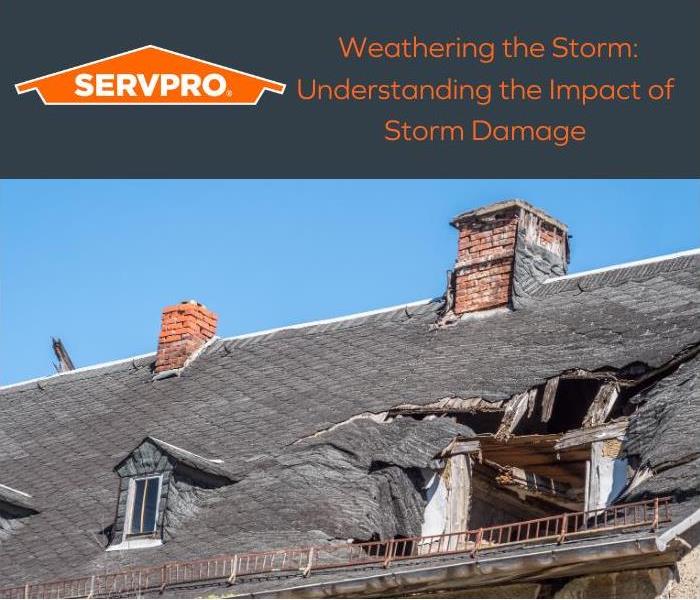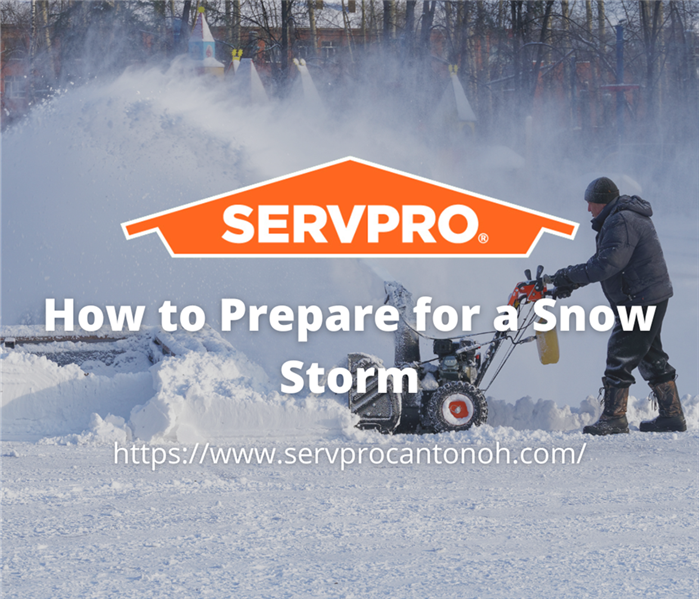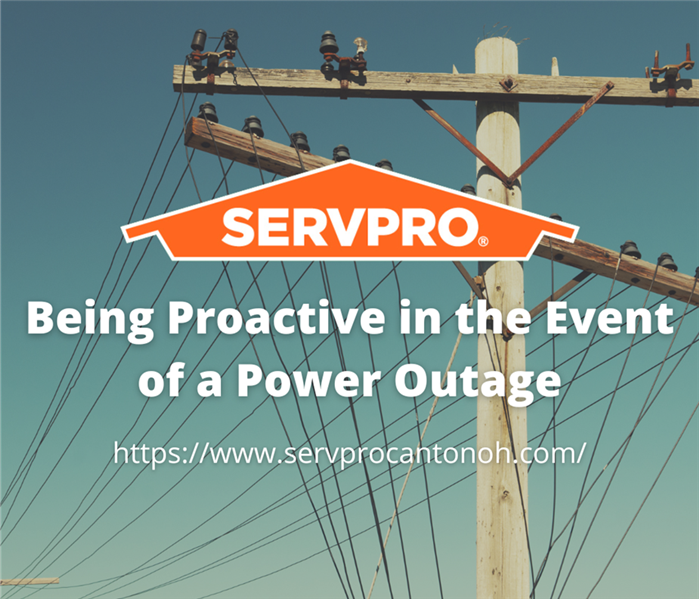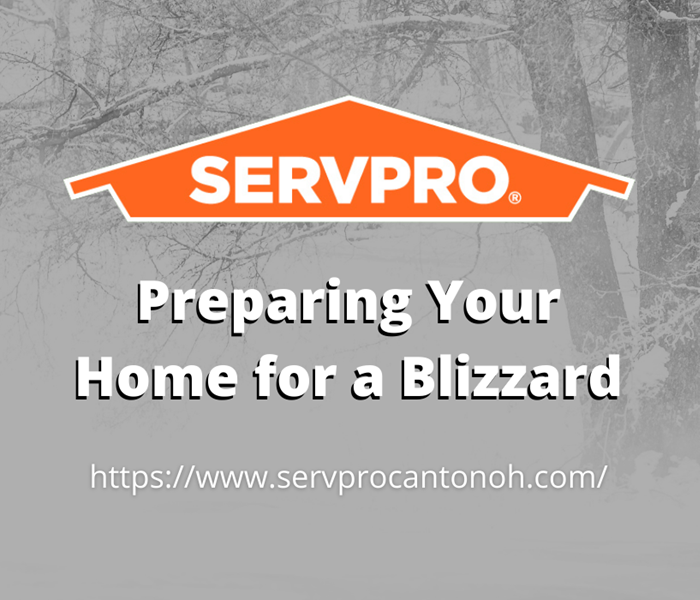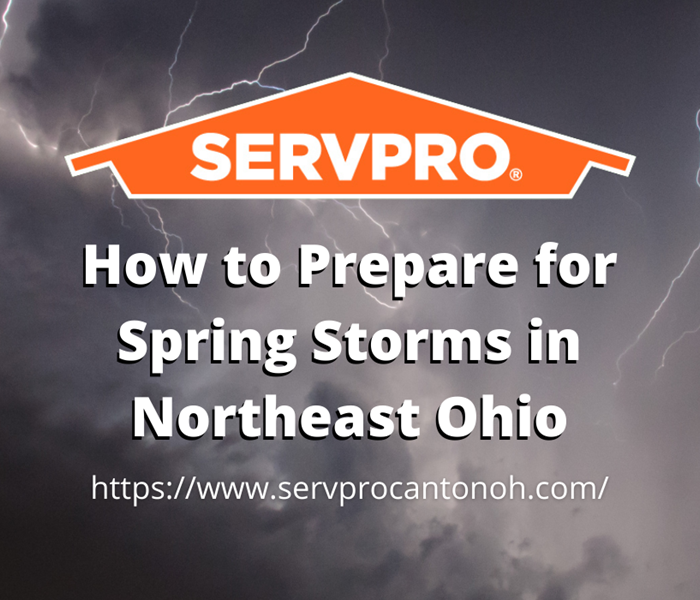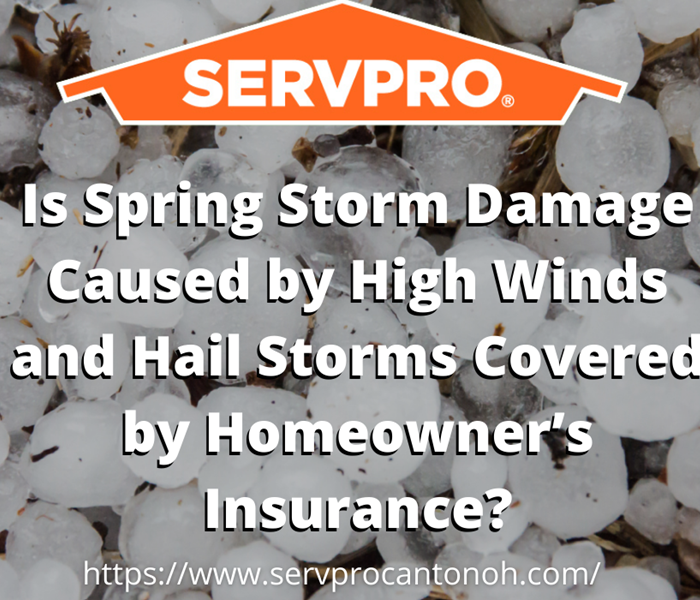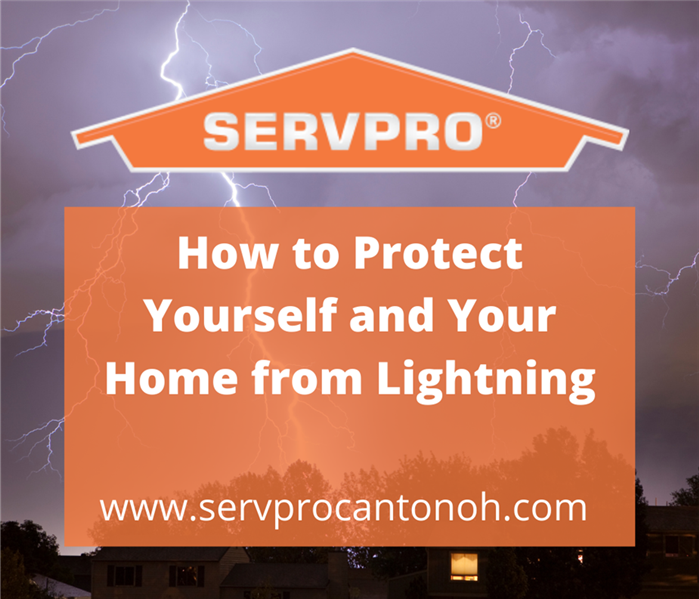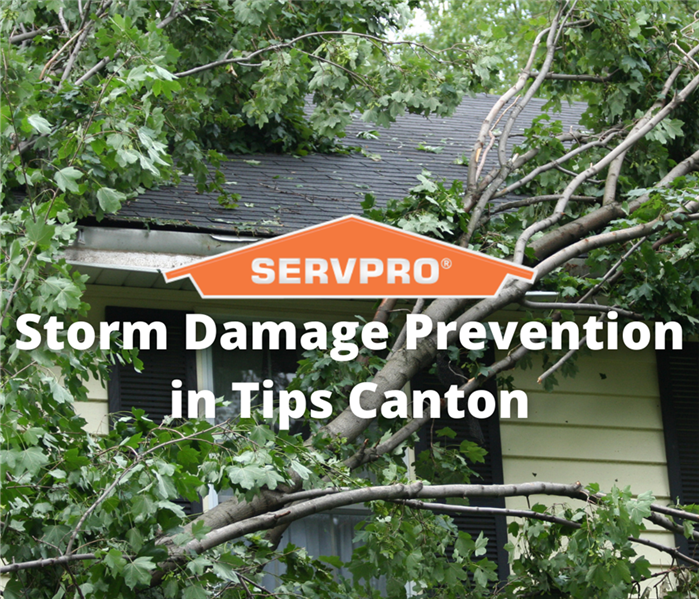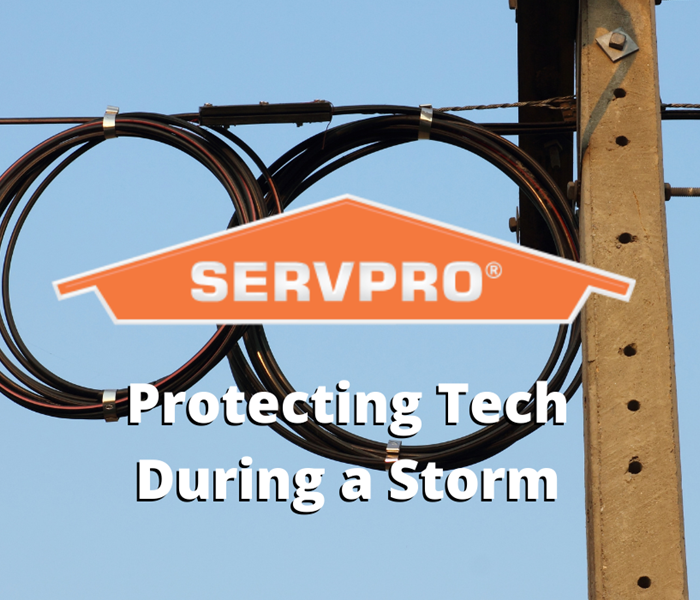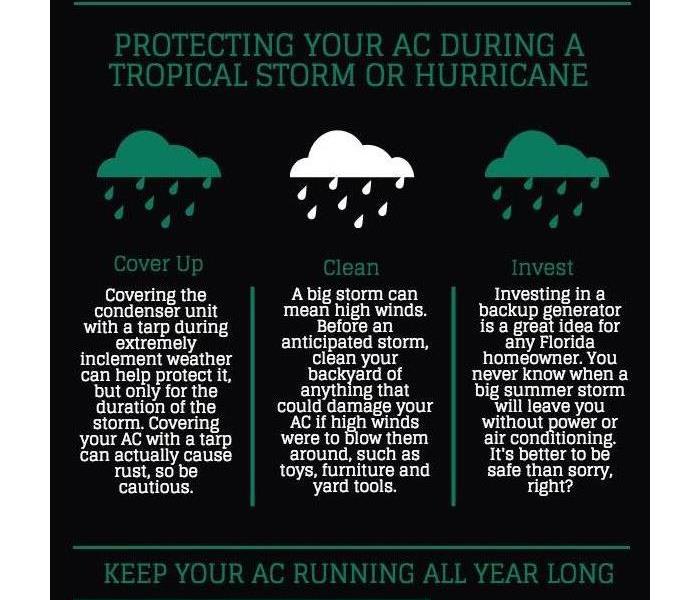Recent Storm Damage Posts
Storm Damage Recovery: The Importance of Professional Water Extraction and Drying
8/20/2024 (Permalink)
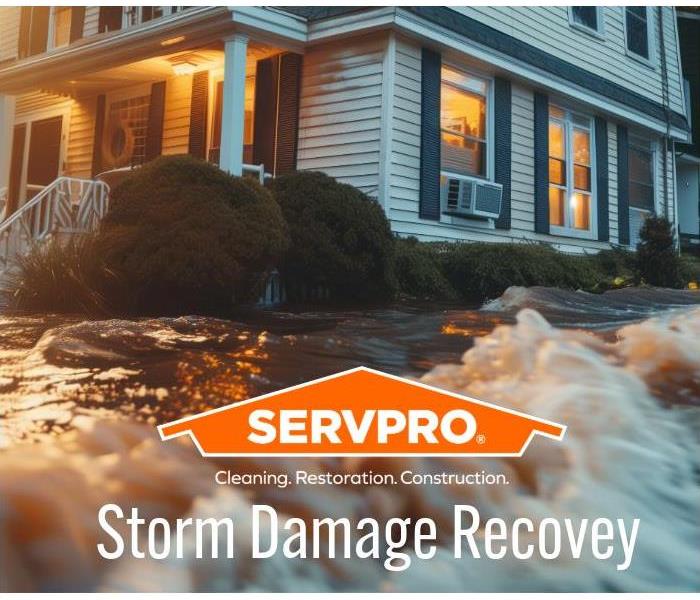 Professional water extraction and drying are vital components of storm damage recovery.
Professional water extraction and drying are vital components of storm damage recovery.
When a storm hits, the aftermath can be overwhelming for homeowners. Flooded basements, soaked carpets, and waterlogged walls are just a few of the challenges that can arise. While it may be tempting to try and handle the cleanup on your own, professional water extraction and drying are critical to preventing further damage and ensuring a safe, healthy living environment. At SERVPRO Team Johnson, we specialize in storm damage recovery and know firsthand the importance of addressing water damage promptly and effectively.
Why Professional Water Extraction Matters
Water damage following a storm can lead to a host of issues if not addressed quickly. Standing water can seep into the structural elements of your home, weakening the foundation and compromising the integrity of the building. This can result in costly repairs down the line. Professional water extraction involves the use of specialized equipment to remove water from affected areas thoroughly.
1. Preventing Structural Damage:
When water is left to sit, it can penetrate porous materials like wood and drywall. Over time, this water can cause these materials to swell, warp, or rot, leading to significant structural damage. By using industrial-grade pumps and vacuums, professionals can remove large volumes of water quickly, preventing these issues from taking root.
2. Protecting Your Belongings:
Water can ruin personal belongings, including furniture, electronics, and important documents. Professional extraction helps minimize the damage to these items. SERVPRO Team Johnson utilizes advanced techniques to salvage as much as possible, reducing the need for costly replacements.
3. Reducing the Risk of Electrical Hazards:
Floodwater can pose serious electrical risks. Professionals are trained to handle these situations safely, ensuring that power sources are managed correctly to prevent accidents.
The Role of Professional Drying
After the water has been extracted, the drying process is equally crucial. Even if visible water has been removed, moisture can linger in walls, floors, and other hidden areas. This residual moisture creates the perfect environment for mold growth, which can begin within 24-48 hours after water exposure.
1. Preventing Mold Growth:
Mold thrives in damp conditions, and once it starts growing, it can spread quickly throughout your home. Not only can mold cause structural damage, but it also poses serious health risks, including respiratory issues, allergic reactions, and other illnesses. Professional drying techniques, such as the use of air movers and dehumidifiers, ensure that all moisture is thoroughly removed, reducing the risk of mold infestation.
2. Maintaining Indoor Air Quality:
Moisture left in a home after a storm can lead to musty odors and poor indoor air quality. This can be particularly problematic for individuals with asthma or other respiratory conditions. Proper drying eliminates excess humidity, improving air quality and making your home safe to live in again.
3. Ensuring Comprehensive Restoration:
The drying process is essential for ensuring that all areas of your home are fully restored. If moisture is left behind, it can continue to cause damage over time, leading to ongoing repairs and expenses. By trusting professionals like SERVPRO Team Johnson, you can be confident that your home will be thoroughly dried and restored to its pre-storm condition.
Why Choose SERVPRO Team Johnson?
SERVPRO Team Johnson has extensive experience in storm damage recovery, including professional water extraction and drying. Our team of certified technicians is equipped with the latest tools and technology to handle even the most severe water damage. We understand the urgency of storm damage recovery and are committed to responding quickly to prevent further damage and protect your home.
In addition to our expertise, we prioritize customer satisfaction and work closely with homeowners to ensure a smooth and stress-free recovery process. From initial assessment to final restoration, we’re with you every step of the way.
In conclusion, professional water extraction and drying are vital components of storm damage recovery. By addressing water damage promptly and effectively, you can prevent further structural damage, protect your belongings, and reduce the risk of mold growth. Don’t take chances with your home—trust the experts at SERVPRO Team Johnson to restore your property to its original state and ensure a safe, healthy living environment for you and your family.
Keeping It Simple: The Power of a Quick Reference Guide for Emergency Situations
8/2/2024 (Permalink)
 In the world of commercial businesses, emergencies are unpredictable and can create chaos in an instant. Simple EAP allow your team to act fast.
In the world of commercial businesses, emergencies are unpredictable and can create chaos in an instant. Simple EAP allow your team to act fast.
In the world of commercial businesses, emergencies are unpredictable and can create chaos in an instant. From natural disasters and fires to medical emergencies and security threats, the ability to respond effectively is critical. While comprehensive emergency plans are essential, they can sometimes be overwhelming in high-pressure situations. This is where the value of simplicity comes into play. A smaller, quick reference guide can provide your staff with an easy-to-use format, reducing confusion and chaos. Here’s why a simple, straightforward guide is invaluable in managing unexpected emergencies.
The Need for Simplicity
During an emergency, the brain's ability to process information can be impaired by stress and panic. Detailed and complex procedures can become difficult to follow, leading to delays and mistakes. A simple guide, focusing on the most crucial actions, can help staff quickly understand and execute necessary steps, ensuring a more efficient response.
Benefits of a Simple Quick Reference Guide
1. Easy Accessibility:
A smaller, concise guide can be easily accessed and distributed across your business premises. Employees can keep it in easily reachable places, such as at their desks, in break rooms, or at reception areas. This accessibility ensures that, in an emergency, staff can quickly grab the guide and start following the outlined procedures.
2. Clear, Actionable Steps:
A quick reference guide strips down to the essentials, providing clear, actionable steps for different types of emergencies. By focusing on immediate actions—like evacuation routes, emergency contacts, and basic safety measures—employees can act without needing to sift through extensive documents.
3. Reduced Confusion and Panic:
In chaotic situations, a straightforward guide can reduce confusion and panic. When staff know exactly what to do and where to go, they can maintain calm and order, helping to manage the situation more effectively. This clarity can prevent injuries and facilitate a smooth evacuation or response.
4. Consistent Response Across the Team:
A simple guide ensures that all employees, regardless of their position or experience level, can follow the same procedures. This consistency in response helps coordinate efforts and prevents miscommunication, ensuring everyone is on the same page during an emergency.
5. Quick Decision-Making:
With limited information to process, staff can make quick, informed decisions. This agility is crucial in emergencies where time is of the essence. Whether it’s identifying the nearest exit, knowing how to use fire extinguishers, or contacting emergency services, a quick reference guide empowers employees to act decisively.
6. Regular Updates and Training:
A simpler format is easier to update and disseminate. As emergency procedures or contact information change, the quick reference guide can be swiftly revised and redistributed. Additionally, training sessions can be more focused, ensuring that employees understand and remember the key points.
Creating an Effective Quick Reference Guide
To create a practical quick reference guide, consider the following tips:
1. Prioritize Critical Information: Include only the most essential information that is immediately actionable. This may include evacuation routes, emergency contacts, and first aid procedures.
2. Use Clear and Simple Language: Avoid jargon and technical terms. Use straightforward language that everyone can understand, regardless of their familiarity with emergency protocols.
3. Incorporate Visual Aids: Visuals like maps, diagrams, and icons can convey important information quickly and clearly. Use these aids to highlight evacuation routes, assembly points, and safety equipment locations.
4. Keep It Compact: The guide should be compact enough to fit in a pocket or be posted on walls without taking up too much space. This ensures it's always within reach.
5. Regularly Review and Update: Ensure the guide is reviewed regularly and updated as needed. This keeps the information accurate and relevant, reflecting any changes in your business layout or emergency contacts.
SERVPRO's Emergency Ready Plan
SERVPRO's Emergency Ready Plan provides a simple format that is perfect for commercial properties. It offers an accessible and comprehensive solution that outlines critical information such as emergency contacts, facility details, and shut-off locations for utilities. This plan is designed to be straightforward and easy to understand, ensuring that all staff members can quickly access and utilize the information during an emergency. By having this plan in place, businesses can reduce the chaos and confusion often associated with unexpected damage, facilitating a swift and organized response.
Conclusion
In the midst of an emergency, simplicity can be a lifesaver. A quick reference guide offers a streamlined approach, enabling staff to act swiftly and confidently. By focusing on clear, essential steps, you can reduce chaos and ensure a coordinated response. Remember, the goal is not to replace a comprehensive emergency plan but to complement it with a user-friendly tool that enhances your team's ability to respond effectively. Keep it simple, keep it accessible, and keep your business prepared. SERVPRO's Emergency Ready Plan is an excellent resource to help you achieve this level of preparedness and peace of mind. Contact SERVPRO of Canton for more information 330-966-2377
Weathering the Storm: Understanding the Impact of Storm Damage
8/1/2023 (Permalink)
Storms can strike unexpectedly, leaving a trail of destruction in their wake. From powerful hurricanes and thunderstorms to relentless blizzards and flash floods, Mother Nature's fury can wreak havoc on homes and businesses alike. Understanding the impact of storm damage is crucial in preparing for such eventualities and seeking timely restoration solutions.
Storm damage comes in various forms, including structural damage, water intrusion, fallen trees, roof leaks, and electrical hazards. These elements can compromise the safety and integrity of buildings, posing risks to occupants and valuable assets. Beyond the visible damage, storms can also leave behind insidious issues like mold growth due to prolonged moisture exposure.
Prompt action is key to mitigating storm damage's long-term effects. Engaging professional storm damage restoration services, like SERVPRO, can make all the difference in minimizing losses and facilitating a speedy recovery. These experts are equipped with the knowledge, tools, and experience to assess the extent of damage, address safety hazards, and begin the restoration process efficiently.
Preparedness is equally vital in dealing with storm damage. Simple steps like securing outdoor items, reinforcing doors and windows, and having an emergency kit ready can significantly reduce potential risks. Regular maintenance and inspection of properties can also help identify weak points and address them before a storm strikes.
Storm damage is a powerful reminder of the uncontrollable forces of nature. By understanding its impact and embracing preparedness, individuals and businesses can better weather the storm's aftermath and emerge stronger in the face of adversity. Remember, in times of crisis, professional storm damage restoration services stand ready to help restore what matters most.
How to Prepare for a Snow Storm
8/29/2022 (Permalink)
It is typical to have some preparation for snowstorms, and there are great ways to prepare and make sure that you and your family are being as careful and cautious as possible.
Communication
Communicating with your family about the snowstorm is a great way to make sure that you are all on the same page. When you are all on the same page about what to do and what not to do, it will be easier to make sure that the entirety of the snowstorm goes smoothly.
Insulation
Make sure that your Insulation is installed correctly. This will make a huge difference when temperatures drop, and if it is not installed properly, it will be horrible once you realize that it wasn’t and you can’t have anyone come out to look at it because of the road conditions.
Storm Windows
The installation of storm windows can help to keep cold air out immensely, and if this is not obtainable, covering them with plastic is a good alternative.
Fireplace Check
If you have a fireplace, it is vital that you are getting it checked semi-regularly. This will make sure that you have no issues when temperatures drop significantly and the weather gets nasty outside. Once you know that your fireplace is in great condition, stocking up on wood or coal is a great way to ensure that you will have as much heat as possible during the storm.
Radio/Television
It is important during the entirety of any storm to stay updated and vigilant in regard to what is happening. The best way of doing this is to always have the TV or the radio. This will help you to stay updated and make sure that you are two steps ahead of the storm and prepared for when it comes.
There is a multitude of ways to prepare for snowstorms and there is always a chance that there may be some damage to your home, and in that case, SERVPRO is here to help you and your family 24/7.
Being Proactive in the Event of a Power Outage
7/27/2022 (Permalink)
Power outages are not as common as rain, or even snow, but they still have a chance of happening. In the occurrence of a potential power outage, you need to be proactive and prepared. Here are some things to consider during the event of a power outage.
Keep freezers and refrigerators closed
It’s important to make sure you are not opening your refrigerator or freezer in the event of a power outage. Your refrigerator will typically keep food cool for four hours. Your freezer will keep food cold for around 48 hours. You may want to use coolers with ice for other items that you may need to keep cold.
When you’re consuming food, make sure you’re consuming food that does not require refrigeration or freezing.
Do not use a gas stove to heat your home
By not using a gas stove to heat your home, you are preventing the chance of carbon monoxide poisoning.
Check on your neighbors and other loved ones
It’s best to find out how others you care about, and others in your community are holding up. This is important for the elderly as well as those who are young. These individuals are more vulnerable to temperatures.
Disconnect any appliances and electronics
Doing this will help you to prevent any electrical surges and any other damage that could possibly be preventable.
Preparing Your Home for a Blizzard
2/2/2022 (Permalink)
NORTHEAST Ohio can get snow – and a lot of it. So what should you do to prepare your home for a blizzard?
Six simple tips can make handling the sudden deep snow that much easier for everyone – preparation is well worth the time investment.
Start by making sure you have a good stock of salt and sand to grit your driveway and sidewalk. Do not wait for the snow to fall – it is almost too late to be useful then. Road crews start shortly before the snow is expected, so the salt is in place and doing its job from the first flakes and is melting snow on impact. Coarse sand is useful for laying down on patches after the snowing stops but keep it inside as it can freeze solid.
Check your snow blower – make sure it starts and works before you need it, especially if it has been in the garage for a year. Put it in position for where you want to start clearing your pathway and cover with a tarp. Make sure you have some spare supplies and plenty of fuel.
Your gutters are going to be working overtime when the blizzard is over and the snow starts to melt so make sure they are clear of leaves and debris, and check downspouts are also clear to prevent an ice dam from building up.
Prepare for the melting – is your sump pump working and switched on? It does not hurt to check it out with a bucket of water to see if it kicks on.
Cold weather causes ice – and this can happen in pipes too, especially if your heat goes out, so keep stored water on hand in case you find your taps stop running.
And finally grease your snow shovel. Really. Use some non-stick cooking spray on the shovel’s blade – and the snow will slide off the shovel that much more easily than if you do not.
How to Prepare for Spring Storms in Northeast Ohio
2/2/2022 (Permalink)
In late March, the National Weather Service holds Severe Weather Awareness Week to educate people about the upcoming spring storm season. If you live in Ohio, then you know how quickly severe weather arises. In fact, most Ohio tornadoes occur in May, June, and July.
Now that we’re deep into the spring storm season, it’s important to revisit the helpful information discussed during Severe Weather Awareness Week.
At SERVPRO we know how to fix your property, but we can’t fix you, so always protect your most important and irreplaceable assets--yourself and your loved ones.
To best protect yourself, you need to know what you’re protecting against. That’s why it’s important to know some weather terminology.
What’s the difference between a severe thunderstorm watch and a warning?
A watch is normally in effect for several hours and tells you that currently, weather conditions could develop into severe thunderstorms. A warning tells you that current storm conditions could get worse and include heavy rain and strong winds.
You can brush up on your severe weather terms at weathersafety.ohio.gov.
Once you feel adequately educated, it’s time to make a plan. Having a plan in place takes away the panic when a severe weather event happens. Make sure you can answer these questions:
- How will you communicate with your family?
- Where will you meet?
- What supplies do you need if you lose power and water?
- Do your children know what to do if they’re not home or outside?
- What precautions should you take when lightning is striking?
- Who should you call if you are injured or your home is damaged?
Knowing what to do can make bad situations a little bit better because you can react quickly.
What should you have on hand in case of severe weather? Have an emergency kit stocked and ready. Here’s a list of supplies you should include:
- First Aid kit
- Flashlights and batteries
- Phone charger and mobile power bank
- 3 day’s supply of food and water
- Blankets to keep warm
Arming yourself with the proper knowledge and supplies for a severe weather event puts you well ahead of most people, who don’t prepare at all. We never think severe weather will affect us until it does. Don’t fall into this trap: be safe rather than sorry.
Is Spring Storm Damage Caused by High Winds and Hail Storms Covered by Homeowner’s Insurance?
2/2/2022 (Permalink)
You never know when a severe thunderstorm is going to hit, especially in late spring. The sky can turn ominous and the wind can move in quickly. So it’s best to be prepared for these kinds of storms and the potential damage they can cause your property. While it’s not likely your home will be struck by lightning, high winds and hail are the main culprits of storm-related property damage in the spring.
High winds can blow objects at high speeds onto your roof. Wind can get under loose shingles leaving your roof vulnerable to further wind and water damage. Hail can also damage your shingles, not to mention your windows and siding.
If any of this damage occurs, the question becomes, “Is storm damage caused by high winds and hail covered by homeowner’s insurance?”
Usually, the answer is yes. But we recommend checking with your insurance agent to make certain your home is covered for wind and hail damage. Typically homeowner’s insurance policies will cover wind and hail damage to the roof and siding of your home when they are caused by a thunderstorm, tornado, hurricane, hailstorm. But, again, check your homeowner’s insurance policy, as policies can differ based on provider and the type of policy.
How to Protect Yourself and Your Home from Lightning
9/6/2021 (Permalink)
The CDC puts your odds of being struck by lightning at 1 in 500,000. But they also say, “Lightning is one of the leading causes of weather-related fatalities.”
Eitherway, you’re odds are much better than your home’s. 2020 saw 17 U.S. lightning fatalities. In contrast, insurance policyholders made 77,000 lightning claims in 2019. The claims resulted in more than $900 million in damages.
Protect your home from lightning
These statistics show that lightning is a serious problem for homeowners. So check out these tips for protecting your home in 2021.
Lightning Protection System
Have a lightning protection system professionally installed. These systems give lightning a designated path to follow, so it doesn’t travel to unprotected wiring or piping in your home. They consist of air terminals (lightning rods), main conductors, ground rods, bonds, surge protectors, and even tree protection.
Lightning protection systems should only be installed by contractors listed by Underwriters Laboratories and certified by the Lightning Protection Institute.
Surge Protection Devices (SPDs)
These devices redirect electrical surges that come to your home through powerlines. They protect your appliances by diverting the electrical surges into the ground. They should also be professionally installed.
How to protect yourself from lightning
If you’re indoors, and you know lightning is coming, unplug electrical appliances. If lightning is already striking, stay away from all electrical appliances, windows, doors, piping, water sources like sinks and showers, and landline telephones.
If you’re outdoors, find shelter, preferably in a lower elevation. Lightning travels by the path of least resistance, so the taller an object is, the more likely it will be hit. A vehicle with the windows closed is a safe option.
Never use a tree, as they're often the tallest structures and most likely to be struck. Also stay away from telephone and utility poles, and any metal objects.
If you’re interested in learning more about protecting you and your home from lightning, contact the Lightning Protection Institute.
If you’re home or business suffered damages from a lightning strike, and you need emergency services, contact our 24/7 emergency service line. We have over 1,700 U.S. and Canadian locations, so we’re strategically positioned to be faster to any size emergency.
How to Secure Your Outdoor Furniture in Severe Weather
8/4/2021 (Permalink)
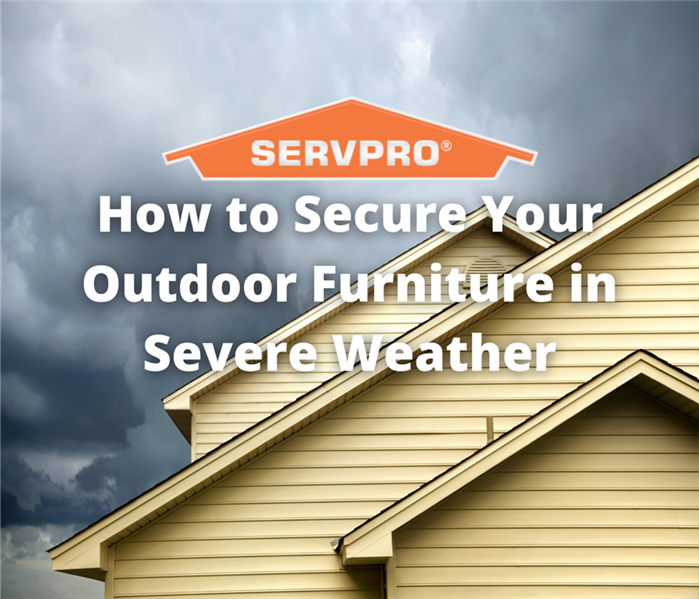 Ensure the protection of your valuable outdoor property by taking these steps.
Ensure the protection of your valuable outdoor property by taking these steps.
Finally, the weather is warming up and Ohioans are itching to get outside and use their outdoor furniture. But with warmer weather comes severe storms. Storms notorious for blowing away your furniture.
So how can Ohioans secure and protect their outdoor furniture?
This is a great question since tornado season starts in April.
Check out these five simple steps to keep your outdoor furniture where it should be.
Store it
Seat cushions, pillows, plastic lawn chairs, and potted and hanging plants can blow away. Bring those light-weight and fragile objects inside your garage or home.
If you have an outdoor umbrella, close and secure it. If you can’t bring it inside, make sure the umbrella has a heavy base and is firmly anchored. If it’s loose in the base, lay it on the ground in a safe place.
Cover it
Outdoor furniture covers come in many sizes and are great for wood and wicker patio furniture. Most hardware and big box stores carry durable weather-resistant covers. Find covers that fit your furniture. Invest in rope, bungee cords, ratchet straps, or even chains to hold the covers in place.
If you don’t have furniture covers, and you need something quick, a tarp will get the job done.
The best part about furniture covers is they keep your furniture dry and clean. Simply remove the covers and get back to relaxing!
Weigh it down
If your patio furniture is light, and you can’t bring it inside, the next best thing is to weigh it down. Sandbags can be helpful. Pile sandbags on your umbrella base. Stack light-weight chairs and top them with a sandbag.
You can even use sandbags to hold down your furniture covers.
Trim it
These last two tips take a bit of forethought but are important. Inspect your trees and shrubs for low-hanging or dead limbs. Especially limbs near your home. In a strong storm, these limbs can fall and damage your outdoor furniture, your home, and your vehicle.
Pro tip: add trimming dead limbs to your regular lawn maintenance to prevent future damage.
Plant it
Plant a windbreak -- a row of trees or shrubs that blocks wind. They not only protect your property, they also provide privacy and look beautiful. From small shrubs to tall pines, you can find the perfect plants to fit your needs.
Follow these 5 easy steps, and you’ll get years of use out of your outdoor furniture.
Storm Damage Prevention Tips in Canton
7/8/2021 (Permalink)
Although disaster sometimes cannot be foreseen, the damage can be somewhat prevented. There are steps that any homeowner or business owner can take in order to stay prepared and ready if a storm should strike your neighborhood. The preventative measures one can take range from minor improvements to structural upgrades. And no matter the task (big or small) you will be happy that you made the effort if a storm should strike. So, what are some of the best practices when it comes to storm proofing your home?
- Prevent water damage and leakage – Make sure that windows and doors do not have any cracks or exposed areas. Water seeping in can cause damage not only to the structure that it is penetrating, but also the interior of your home. Avoid water damage and mold by using proper materials to seal up and openings.
- Maintain your surroundings – Take care of trees and gutters around your home. When you make sure to get rid of any dead or hazardous branches, that is one less threat of structural damage. Additionally, make sure to clear out your gutters to avoid water buildup.
- Upgrade – Although upgrades may cost a little more time and money, they may be a stress saver later on down the road. Whether it is your roof, siding or even windows, updated materials will better withstand harsh weather.
- Cross your Ts and dot your Is – Make sure to check all of the areas around and inside of your home, including the chimney, basement and attic. It may be as simple as cleaning out your chimney of old debris or patching a hole in the ceiling.
- Button up – If there is a storm on the way make sure to secure all windows and doors and remove any clutter from your yard or driveway. This will help to protect you inside and the outside of your home. Your neighbors may even thank you for not adding to their home damage with the trash cans or bicycles that were left out for the strong winds to carry.
- Have backup – investing in backup power for your home could be a lifesaver if a storm should hit. Not only can it help to protect your electronics, perishables and pipes (if it is cold out), but you will also be grateful for light and electricity if things get really bad.
Although some of these measures may seem like a chore, they can help to save and protect you, your home and your loved ones. Storm proofing is one more investment to make when it comes to safety and security in your life. In addition to these steps, it is a good idea to have a solid plan that everyone is aware of, as well as backup supplies like food, water, and first aid. If disaster should strike, you’ll be glad you took the time.
Having an Emergency Storm Plan in Place
4/5/2021 (Permalink)
 Make sure you and everyone in your building has a safety plan to follow when disaster strikes.
Make sure you and everyone in your building has a safety plan to follow when disaster strikes.
Schools, office buildings, hotels, and hospitals all have plans posted (even practiced) in case of an emergency. So, why not have a disaster recovery plan for you in your own home or business? This may or may not be something that you have considered before, and perhaps it has just been put on the backburner with other tasks. However, this is a task that you may not want to put off; after all, disaster can strike at any time.
By ensuring that you have a solid plan that everyone is aware of, not only will clean-up be easier, but it will help to ensure the safety and well-being of loved ones. So, where exactly should you start and what are the benefits?
- Reduced fear, anxiety, and panic if disaster should strike – Have a good understanding of what disasters you may face. If you live in an area that is prone to tornadoes, you’ll want to make sure there is a safe shelter for everyone. Additionally, you will want to make sure there are provisions in your shelter such as water, blankets, dry food, lights, batteries, etc.
- Avoid confusion and extra stress - Make sure that everyone is aware of the disaster plan and there are clear responsibilities. No matter the age, everyone who lives or works under your plan, everyone should is well versed in what to do if there is a flood, fire, or another natural disaster. Discussing and practicing this plan can help to ensure that everyone is in the loop.
- Less stress with clean-up and repairs - Check with your insurance! Make sure that all of the bases are covered with your insurance, especially that you are covered from floods and other natural disasters.
- No need to worry about replacing items that are irreplaceable. Make sure to keep important documents and keepsakes in a fireproof and waterproof safe. Not only will this help to make the claims and clean up an easier transition, but you can also protect important pictures and documents.
- Less counting later on! Keep an inventory of all valuables. If you should have to file a claim, it will be easier to pull the record out as opposed to trying to scan your stressed brain.
If you decide that it is time to make and follow a disaster plan, make sure that you do your research so that you are well prepared. It is easy to get caught up in life and forget that disasters do happen, but if it should happen, you’ll be glad that you were ready. If you are in the middle of making your plan and are not sure of what contacts to put in your phone, add SERVPRO to the list, we are faster to any disaster!
Protecting Tech During Storms
2/26/2021 (Permalink)
WE know the drill – the tornado sirens go off and we head to our basements to protect ourselves.
A basic human instinct, unchanged throughout time, to search out and seek the safest refuge until the storm literally passes.
While caves have been replaced with basements, we also have other tools at our disposal to help us through harsh weather which can aid us in many ways.
First is protection of our property – if we have enough warning, we will seek to weatherproof our houses with boarded windows and move furniture and possessions to higher levels of our homes to protect against the risk of flood.
But what about our intellectual property? Our data on our computers and our passwords for bank accounts and insurance policies? Make use of modern technology and ensure your valuable data is backed up to a cloud service so it can be fully retrieved even if your computer and hard drive are destroyed.
As you head to the basement with food and water, make sure you grab your smartphone or tablet. This can be a literal lifeline to the outside world during – and after – a storm. Make sure your phone is fully charged and resist the temptation to pass the hours idly scrolling social media or watching a film – you may need that battery power and given the weather you should not rely on your power staying on. In fact, stay away from anything plugged into the electrical supply.
Invest in some cheap battery charging backs and keep them in your storm cellar along with bottled water -they could provide any top ups to your battery you need.
And there are a range of useful apps – but download them well before any storm to save battery power. Put your phone into a power saving mode as well so it lasts as long as possible.
Apps you may want to download include: Zello, which turns your phone into an old-fashioned walkie talkie to connect to emergency services in an old school tried-and-tested manner; Nextdoor, which uses your GPS to connect you with people nearby; and WeatherPlus, to get the latest updates on the storm progression. Add in your local television station for up-to-the-minute news and updates about the storm.
And if you must evacuate your home for the storm’s duration, the recent innovations in home security can help you keep a literal eye on your property.
There are now dozens of smart internet-connected devices available such as door cameras that people use to protect their homes from intruders – but the same devices can give you the reassurance your home is ok as you can literally get a live feed to your phone or tablet to see the storm’s progression. Other devices include water sensors, motion sensors, remote cameras, door lock sensors and smoke detectors all of which can feed you real time information and offer push alerts if they are triggered. In these cases, no news is good news.
Lightning Hazards on Your Property
2/5/2021 (Permalink)
 Be prepared when lightning strikes near your Canton home.
Be prepared when lightning strikes near your Canton home.
There are many myths that involve lightning, some of which tell you exactly the opposite of what you should be doing. Getting struck by lightning is known as an extremely rare occurrence, comparable to winning the lottery, but looking at the number you are actually way more likely to be struck by lightning than to win the lottery. It is more common than people think and it is important to know the potential hazard to make sure you and your home are as safe as possible.
Lightning presents 3 main hazards to your home if it were to be directly hit:
- Fire Damage- The biggest threat lightning holds to your home is starting a fire. Your home along with a lot of the items in it are made from flammable materials that could easily be ignited if struck.
- Power Surge Damage- If lightning chooses any of the home's electrical wiring as its primary or secondary path, the explosive surge can damage even non-electronic appliances that are connected. Even if most of the lightning current takes other paths to the ground, the home's electrical system will experience enough of a surge to cause potentially significant damage to anything connected to it, electronics in particular.
- Shock wave Damage- Lightning can easily break and crack brick, concrete, stone, and cinder block. Brick and stone chimneys usually will take a huge hit. Lightning's shock waves can blow out plaster walls, shatter glass, create trenches in soil and crack foundations.
Your home is a safe shelter during a lightning storm, but there are some precautions to take to ensure your safety.
- Avoid water - stay out of the shower and bath during a storm.
- Avoid electronic equipment,
- Avoid corded phones - Cordless and cell phone use is okay
- Avoid all windows, doors, porches, and concrete.
If lightning strikes your home you will want to call 911, lightning can spark fires that will take time to be known. Lightning strikes are an underrated weather hazard as well as unpredictable. There’s not much to be done that can prevent it from striking anywhere, but you can know how to keep yourself safe. SERVPRO of Canton is your storm damage specialist.
Winter Storm Damage Tips
2/4/2021 (Permalink)
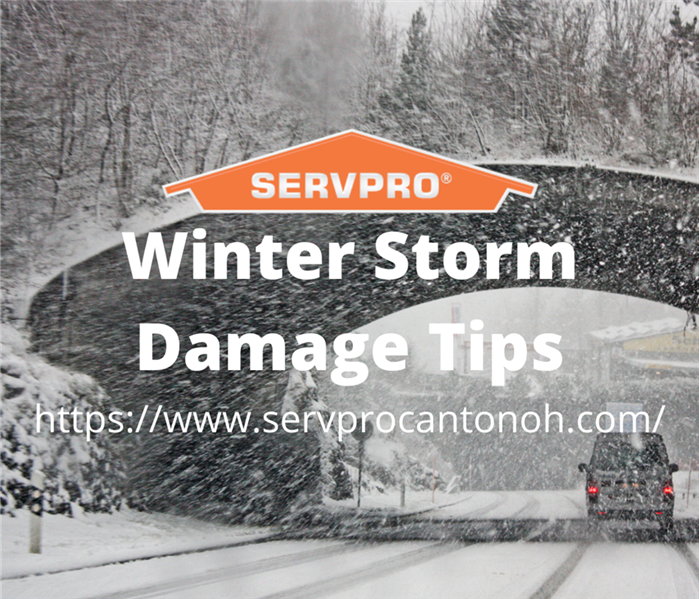 Make sure you're prepared when the winter weather hits Canton.
Make sure you're prepared when the winter weather hits Canton.
It is the time of year when the days get shorter and you never really can tell what time it is. Looking out the window you think, How is it already so late? then look at the clock and it really is only 5:30 pm. Along with the early sunsets and bitter cold also comes winter storms ready to wreak havoc on your home. Inform yourself of the potential dangers that can cause significant damage so you can take the proper precautions and save yourself a whole lot of money and stress in the long run.
- Ice and Snow can Strain the Roof - Condensation and freezing temperatures can cause severe damage on your roof, including ice dams that lead to roof leaks, strong winds that loosen shingles, and icicles that put stress on your roof. To avoid any major blows to your roof, remove any icicles immediately and fix damaged shingles as soon as the wintry weather allows.
- Ice Dams can Bring Down the Gutters - Clear your gutters of the debris before cold weather arrives, then keep an eye on them in freezing temperatures to make sure they stay clear of dangerous amounts of ice. If ice dams do form, clear out your gutters by applying a de-icing agent or string a heated gutter cable
- The Cold Cracks Caulk - Fluctuations in winter temperature cause caulk to pull away from windows, which in turn creates drafts that let warm air out and cold air in. If you notice that your home is particularly drafty, check your windows and reapply caulk to any cracks to warm up your home and save on energy bills.
- Freezing Weather = Frozen Plumbing - On the coldest days and nights, your plumbing pipes may be at risk for freezing and bursting. To avoid this plumbing catastrophe when temperatures dip, insulate your exposed pipes with heat tape or foam pipe insulation and turn on your faucet to a slow drip to keep water flowing.
- Tree Branches Snap - Wintry conditions can put their life and limb at risk. When subjected to low temperatures and heavy condensation, tree limbs can break and fall on your roof, siding, or power lines. The best way to prevent winter damage to your trees is to prune them during the fall
Being aware of the potential damage and being proactive can be the best thing you do for your home this year. Winter can be a beautiful time of year, the snow on the trees, the relaxing calm you feel with that quiet snowfall muting the world around you, and the holidays full of family and loved ones. Don’t be fooled, the calm beauty can turn your home into a chaotic mess in a matter of minutes with a busted pipe or tree branch through the roof. Prevention is key, it can happen and it will if given the opportunity. Let SERVPRO of Canton help winterize your home and if damage does happen to occur despite your best efforts they are trained and certified in every aspect of home restoration to get your home back in shape with as little headache as possible.
Preparing for Winter Weather in Canton
9/17/2020 (Permalink)
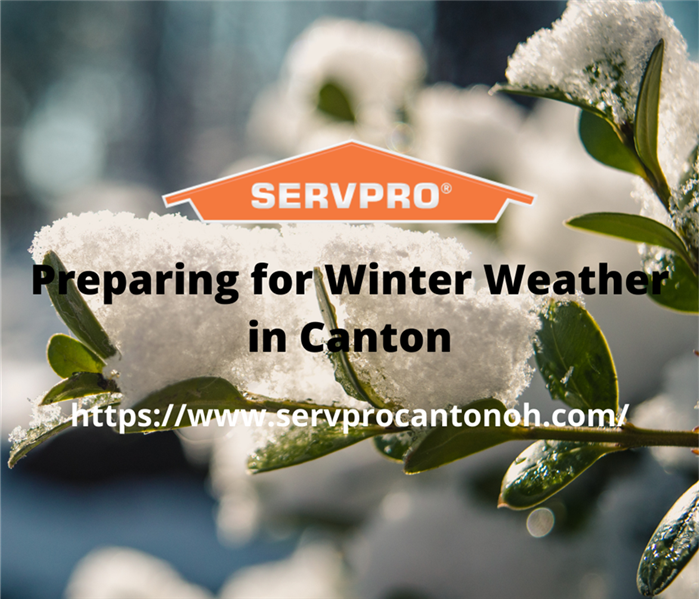 Make sure that you're ready for winter weather by taking a few easy steps this fall.
Make sure that you're ready for winter weather by taking a few easy steps this fall.
As the weather gets cooler, homes get warmer and most people prefer to stay inside in the comfort of their own home. The big question is, how do you protect your haven from winter storms? Living in northeast Ohio, most of us are aware of the climate and weather changes, as well as the potential threats that come along with it. Being familiar with the changes in weather does not always mean that we are completely prepared.
However, there is no need to fret. There are a few things that you can do as the leaves are changing to stay proactive for winter. One of the most important tasks might be making sure that your heating system is clean and functioning as it should. You should replace your system every 12 -15 years, but in the meantime, you can maintain that by changing the filters before the cold weather comes in.
Here are a few other ways to get prepare for winter storms:
- Make sure that your home is in good condition; check your roof and drains to make sure there is no damage that might cause issues in a storm.
- Clean out your gutters to prevent blockage. Proper drainage is important so that water is being directed to where it is meant to go.
- Make sure that you have snow removal equipment available such as a shovel, salt, sand, and other ice-melting materials. If you are unable to maintain the snow and ice on your sidewalks during the winter, make sure you have arranged a professional to take care of it for you.
These are just a few ways to stay prepared as the winter months approach. It is important to stay ahead of the cold not only for the safety of you and your family but also to avoid any major storm damage. Taking these measures could save you both time and money. When you are unsure of what steps to take, such as how to check and clean your ventilation system, give the professionals at SERVPRO a call. If you find yourself in trouble with storm damage to your home or business, give SERVPRO a call at (330) 966-2377. Our highly trained professionals are faster to any disaster!
When Disaster Strikes in Canton
8/28/2020 (Permalink)
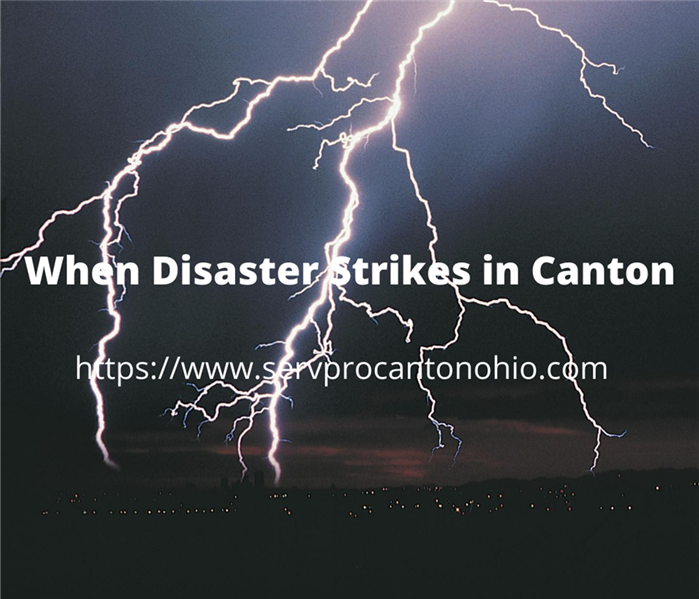 Lightning could be the cause of major disaster in your home or business.
Lightning could be the cause of major disaster in your home or business.
Lightning strikes might not be the most common disaster to befall a person but they can cause substantial property damage. In the United States, there was a total of 109,049 lightning claims for property damage in 2016. Most commonly, the damage is due to electrical surges damaging components or wiring. Power surges from transformer or service line shorts are also often contributing factors. Consider that in less than a microsecond, a lightning discharge can generate up to 200,000 amps of electricity.
Lightning is caused by an electric potential difference (a voltage) being created between one cloud and another, or between a cloud and the ground. A charge of electrons builds upon the higher cloud while a lack of electrons occurs on the lower part. When lightning strikes a structure, wood and other flammable building materials can easily be ignited when lightning comes in contact or passes through them. Electrical surges are caused when lightning strikes near a power line causing an increase in the amount of electrical current flowing to a wall outlet. This extra burst of electricity is often too much for a surge protector to handle, which can lead to computer and appliance damage. Lightning is the most common natural cause of wildfires.
The latest data available states that fire departments respond to an average of 22,600 fires per year started by lightning. These fires cause an average of nine civilian deaths and $451 million in direct property damage per year. Home fires accounted for 19% of lightning fires while non-residential properties accounted for 7%.
So how can you prevent lightning damage to your home or business property? The key to avoiding lightning damage is to channel the lightning to the ground without allowing it to damage the structure or anything else of value along the way. A professional whole-building surge protection system can be installed that takes your entire structure, surrounding structures, and landscaping into consideration when grounding for lightning strikes. Systems should be certified and approved. Of course, this type of protection is expensive so here are some optional ways to protect property and the lives of the people inside:
- Lightning rods can help direct lightning strikes safely away from a property if properly installed. Unfortunately, lightning might not strike the lightning rod because it does not attract lightning. If hit, however, it will channel the lightning to the ground.
- Keep taller trees a safe distance from your property.
- Unplug or disconnect appliances, internet, antennas, satellite dishes, and electrical equipment when you first hear the clap of thunder.
- Install surge protectors. They can help but are not foolproof if the strike is powerful.
- Connect telephone, cable/satellite TV, and network lines to a surge suppressor.
- Stay away from all plumbing during a lightning storm as the pipes of the property make excellent conductors.
- Stay off the landline phone. 4-5% of people struck by lightning were talking on corded phones.
Unfortunately, there is no way to prevent a lightning strike, but you can reduce the likelihood of damage or injury by implementing the strategies outlined above. When you hear thunder or see lightning in the sky, take precaution, and protect yourself and your property.
Mitigate Storm Damage with Regular Maintenance
7/17/2020 (Permalink)
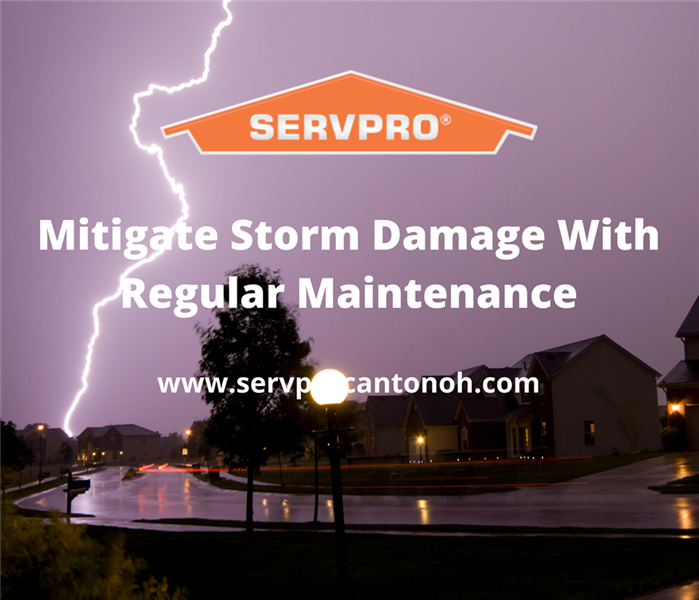 You can't control when a storm is going to happen but you can help limit your risk by keeping your property maintained.
You can't control when a storm is going to happen but you can help limit your risk by keeping your property maintained.
We all know that in Canton, Ohio we can expect our fair share of severe storms. Spring and Summer are major culprits for high winds, heavy rains, and lightning in our area. These extreme weather conditions could cause trouble for home and business owners by inflicting damage on their property. Sometimes, these unfortunate instances are entirely out of our control but there are a few things we can do regularly to help limit the amount of damage that severe weather will do when it inevitably comes our way.
- Test your sump pump. Testing is easy and anyone can do it. Simply fill the pump pit with water and see if it begins to drain. If it doesn’t, it needs maintenance to do its job when flooding happens.
- Clean your gutters. Keeping gutters clean means that they will be able to drain water off the roof and away from your building. Clogged gutters and downspouts could mean water damage during a storm.
- Trim your trees. Trees with dead or rotting branches could mean disaster for your home or business during a storm. Proper pruning allows the trees to be stronger and more stable in the face of extreme weather.
- Clear debris from your yard. Debris left laying about could turn into projectiles during a storm and cause damage to your building. Cleaning up yard waste is an easy way to prevent disaster.
- Make sure your roof and siding are in good shape. You shouldn’t have to worry about checking on your home too often but loose or missing shingles and loose siding could leave your home vulnerable to excess damage during a storm.
- Make sure that water can drain away from your building. This might be a bigger project for a professional but if water isn’t moving away from your home or business and is standing or moving towards it instead, you could be at risk for flooding and water damage.
Keeping an eye on these areas and items around your building could save you a lot of trouble in the long run. If storms come through and damage your property, however, know that you can call on SERVPRO of Canton to help you. We are disaster restoration and cleaning experts, with a staff of highly-trained technicians on call 24/7/365 to respond when you are in need. Make sure you call SERVPRO when things go wrong.
Storm and Water Damage Need A Quick Response Time.
4/3/2020 (Permalink)
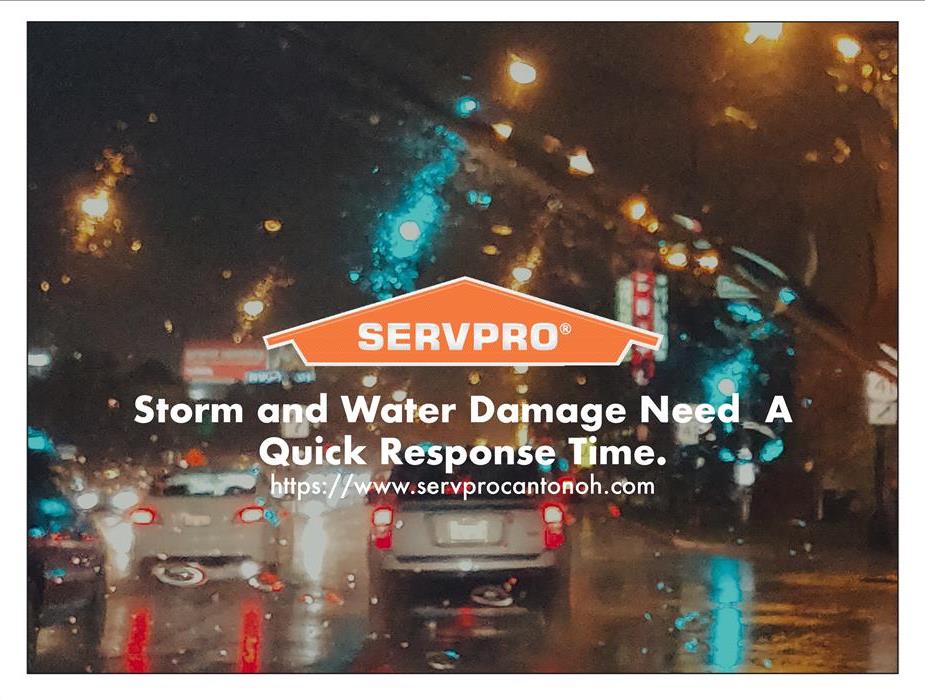 Call anytime: (330) 305-2650 any time of the day, someone is waiting to discuss your unique situation and help you determine the best course of action
Call anytime: (330) 305-2650 any time of the day, someone is waiting to discuss your unique situation and help you determine the best course of action
Floods, rainstorms and tornadoes can become massive water damage during the spring and summer months.
Water damage can be so much more than wet and soggy carpets. Mold and mildew grow rapidly in damp, humid environments, leaving behind an unpleasant smell, even after the water has been removed.
Damage to a building’s structure can be an issue. When water sits inside a building for a period of time, the walls, ceilings, and floors absorb the water. This can threaten the overall structural integrity of the building.
The absolute first step to take is fast action. The longer the water flows or wet conditions exist, the greater the recovery problem becomes. SERVPRO of Canton is your professional restoration company.
Call anytime: (330) 305-2650 any time of the day, someone is waiting to discuss your unique situation and help you determine the best course of action.
Prepare Your Building for Severe Thunderstorms in Canton Ohio.
3/1/2020 (Permalink)
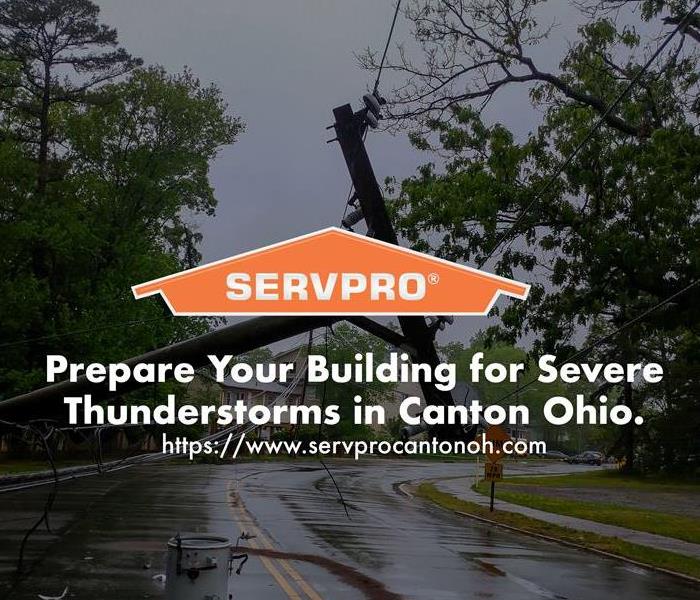 Remember, a quick response time can reduce the overall costs and loss of use. We are ready when you need us at SERVPRO of Canton.
Remember, a quick response time can reduce the overall costs and loss of use. We are ready when you need us at SERVPRO of Canton.
Prepare Your Building for Severe Thunderstorms in Canton Ohio.
With Spring around the corner, we will be getting Severe thunderstorms, in Canton Ohio, before you know it. Let’s face it this should not be taken lightly either: these are the storms that are thunder, lightning and strong winds. It is usually advised to find shelter and stay indoors when severe weather like this strikes. Here are some basic tips to help ensure your building is safe during severe thunderstorms:
1. Keep Trees Trimmed
The exterior of your building can become extremely dangerous during severe weather, especially with unkempt trees. Long branches or innocuous bare limbs can become troublesome in certain instances. It is best to keep trees trimmed.
2. Know First Aid
In an emergency situation, it can be helpful to know what to do for those who might be near you, should a storm arise. you should know basic first aid practices, as well as CPR.
3. Install Defensive Measures
You might want to consider having lightning rods and generators to prevent any damage to electrical systems. There is a great deal of electricity in your home and taking caution should be your priority. Severe storms can wreak havoc on electrical systems.
Remember, a quick response time can reduce the overall costs and loss of use. We are ready when you need us at SERVPRO of Canton. Call anytime: (330) 305-2650 anytime of the day, someone is waiting to discuss your unique situation and help you determine the best course of action.
Prepare For An Ice Storm in Canton Ohio
2/3/2020 (Permalink)
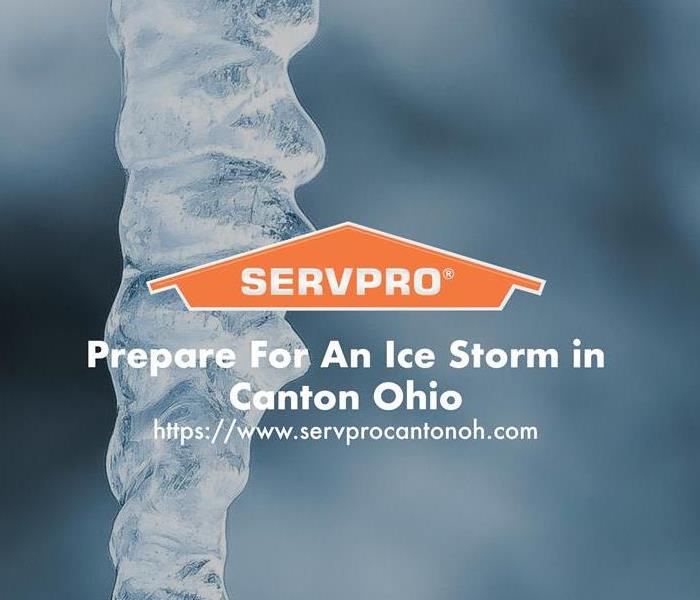 It is that time of year where the weather can get rough and can cause danger to homes. Call anytime: (330) 305-2650 anytime of the day.
It is that time of year where the weather can get rough and can cause danger to homes. Call anytime: (330) 305-2650 anytime of the day.
It is that time of year where the weather can get rough and can cause danger to homes. Ice can increase the weight of branches by 30 times, causing a major disaster for any local homeowner.
Ice accumulations are caused by freezing rain. Freezing rain is a result of snow falling through an above-freezing warm layer in the atmosphere above the surface of the earth. The rain drops then move into a thin layer of below-freezing air right near the surface of the earth, allowing them to freeze on ground, trees, cars and other objects. Ice is not fun to mess around with. If you hear that an ice storm could happen, here are some tips for you to take in.
What to do before an ice storm
- Turn your refrigerator and freezer to their coldest settings.
- Fill up your car’s gas tank.
- Prepare an emergency supply kit with basic supplies including food, water, a flashlight and extra batteries.
What to do during an ice storm
- Ice can accumulate on branches, power lines and homes. If you must go outside, pay attention to branches that could break.
- A hanging power line could be charged (live) and you could get electrocuted, DO NOT TOUCH.
- Avoid driving; even a small amount of freezing rain can make roads extremely slippery.
What to do if there’s a power outage
- Check your circuit breaker panel to rule out any problems.
- If you live with young children consider temporarily staying somewhere with power.
- Try to stay warm during a power outage by staying inside and dressing in warm clothing.
- Stuff towels and rags underneath doors to keep the heat in.
- Unplug electronics and appliances to avoid a power surge.
- Do not operate generators, BBQs, propane and natural gas appliances inside or the garage as they can cause carbon monoxide poisoning.
- Make sure you have a working carbon monoxide detector with a battery backup.
- Use a flashlight rather than a candle for light.
- If lighting candles, use proper holders and keep out of reach of children. Never leave lit candles unattended.
- Ensure the fireplace screen is in place when burning fuel in a fireplace.
Remember, a quick response time can reduce the overall costs and loss of use. We are ready when you need us at SERVPRO of Canton. Call anytime: (330) 305-2650 anytime of the day, someone is waiting to discuss your unique situation and help you determine the best course of action.
How to Prepare for Winter Storms in Canton Ohio.
10/4/2019 (Permalink)
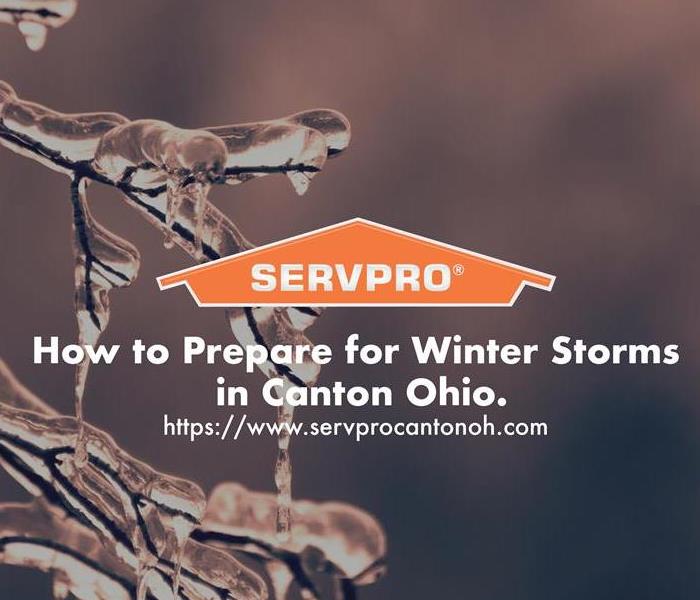 Did you know that 15 percent of home owners have experienced damages caused by water and freezing?
Did you know that 15 percent of home owners have experienced damages caused by water and freezing?
October has arrived and before we know it so will then Thanksgiving, then the holidays. Are you ready for the frigid temperatures, the heavy snowfall?
Did you know that 15 percent of home owners have experienced damages caused by water and freezing? The average cost of these claims is $17,000. The good news is that you can prepare for this before it happens:
- Drain water from all systems and equipment not needed in winter months. This includes landscape sprinklers and air conditioning units.
- Check for any damage to the house and repair damages to the roof. Make sure roof drains are clear and in good condition.
- Clear rain gutters to ensure proper drainage and make sure downspouts are intact and draining in areas away from foot traffic.
- Inspect the exterior of the building for gaps and seal appropriately.
- Trim tree branches and landscape that might come in contact with the building.
- Maintain a temperature of at least 45 degrees Fahrenheit in unoccupied facilities, attics and basements
- Make arrangements for snow removal with a reputable company.
- Make sure you have sand, ice melt and shovels on hand for winter maintenance that won't be covered by your snow removal contractor
Taking preventative actions now while the weather is still warm is incredibly important and could save you a lot of time and money. Begin checking off your maintenance needs while the weather still allows for it. If you are in need of business restoration after a disaster give SERVPRO of Canton a call (330) 966-2377. We are open 24 hours 7 days a week.
Can You Dry Hardwood Floors After A Water Damage?
8/19/2019 (Permalink)
 If you decide to attempt to dry and save hardwood floors in place SERVPRO of Canton has specialized drying equipment.
If you decide to attempt to dry and save hardwood floors in place SERVPRO of Canton has specialized drying equipment.
“Can I dry hardwood floor after water damage?” The amount of homes with hardwood floors is steadily increasing for many reasons, the most prominent being that hardwood floors not only tend to sell homes faster, but they also increase the price. The only downfall is that in the event of a flood or water overflow, hardwood floors cannot be easily taken out and dried like carpet can.
Water damage can increase drastically if not taken care of properly, professionally, and in a timely manner. Here are some of the main considerations:
Response Time - Water damage can be greatly decreased depending on the response time to the problem. Time is of the essence when it comes to hardwood floor water damage – the moisture, temperature, and dust layer beneath a wet wood floor can provide an ideal environment for mold and many other problems.
Type of Wood Flooring - Before you can determine how to properly dry hardwood floor, you need to determine what type of wood flooring you have.
Amount Of Moisture - A flooded hardwood floor can have up to 40% moisture content and can retain well above the normal amount of moisture for weeks if left to dry on their own. Nails may begin to lift, glue may release causing separation between floor pieces, and tongue and groove floors often cup or buckle when moisture has been absorbed.
If you decide to attempt to dry and save hardwood floors in place SERVPRO of Canton has specialized drying equipment that forces airflow beneath the surface of the floor, allowing moisture to be released.
A restoration specialist can inspect the hardwood floor damage to determine the right plan of action for your home, just give us a call (330) 305-2650
Tips to Help Prevent Summer Claims of Canton.
8/15/2019 (Permalink)
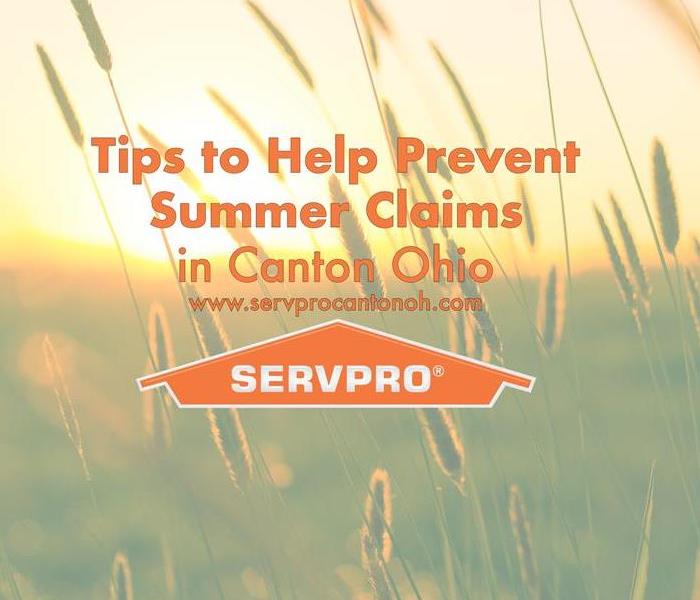 Accidents and emergencies do happen, though these might help prevent damage on your home. If you find yourself in that situation, count on SERVPRO’s
Accidents and emergencies do happen, though these might help prevent damage on your home. If you find yourself in that situation, count on SERVPRO’s
Farmers Insurance states that more than 50% of flood claims get filed during the summer between June and August. Travel increases during summertime for families due to vacations and breaks, the weather sometimes causes unplanned and unexpected troubles.
Add a little preparation and precaution in your household to allow you to take on some of the disasters summer can bring.
- Caution Around Water on Roadways: Although you may FEEL safe driving through water, bear in mind merely six inches of water can reach the bottom of most cars. Flood waters can be dangerous due to depth, flow, and also the unseen debris and possible downed power lines. Losing control of putting yourself in harm’s way out of convenience could be detrimental.
- If in Doubt, Please Re-Route: Be wary of your surroundings and common driving routes. If you travel through underpasses, drainage canals, or similar spots, flash flooding can occur and you should plan alternative routes in case of an emergency.
- Store Valuables Safely: Anything of value such as documents, photos, electronics, or the like need placed on shelves or high enough off the ground should water penetrate your home. Water wreaks havoc enough as is without taking valuable possessions down with any soaking. More irreplaceable items may be better kept in a safety deposit box, safe, or other location.
Accidents and emergencies do happen, though these might help prevent damage on your home. If you find yourself in that situation, count on SERVPRO’s of Canton extremely well-trained professionals to give you the support you need 24 hours a day, 7 days per week including weekends and holidays.
Water Damage Requires a Quick Response
4/16/2019 (Permalink)
Floods, rainstorms and tornadoes can become massive water damage threats to businesses during the often-stormy spring and summer months. Facilities plagued with such water woes this season must take quick action.
Floods, rainstorms and tornadoes can become massive water damage threats to businesses during the often-stormy spring and summer months. Facilities plagued with such water woes this season must take quick action to control many possible problems, experts say.
You won’t see it emphasized on the nightly news when a disaster hits, but water damage can represent potentially huge disasters for businesses and building owners and operators.
Water damage can mean much more to a business than just wet and soggy carpets. There are other common, more significant problems businesses face when water wreaks havoc on property, such as indoor air quality problems. Mold and mildew grow rapidly in damp, humid environments, leaving behind an unpleasant smell that permeates floors, walls and ceilings, even after the water has been removed. It also can create health problems for employees.
Damage to the building’s structure and foundation also can be an issue. When water sits inside a building for a period of time, the walls, ceilings and floors absorb the water, which threatens the overall structural integrity of the building and creates an unsafe environment. Total reconstruction of the building often becomes the only option.
Another major threat to business is the loss of expensive equipment, which often can cost hundreds of thousands of dollars to replace.
To minimize water damage, there are two critical steps that need to be taken:
- Act fast to assess the situation; and
- Control the environment within the building.
Act Fast and Call an Expert
The absolute first step to take is fast action. Damage resulting from water and flooding is very progressive. The longer the water flows or wet conditions are allowed to exist, the greater the recovery problem becomes. A water damage consultant must come in immediately to survey the situation.
In a typical scenario, a team of water damage recovery professionals is dispatched to the site to perform a thorough inspection and fully determine the extent of the damage. A disaster reclamation partner also will develop an intense restoration plan and determine which items are worth restoring and which are better replaced.
You can’t always save everything by drying, but you can save a tremendous amount. It’s not unusual to save between 30 and 70 percent of the cost needed to reconstruct a facility.
Controlling the Interior Environment
Another key in limiting water damage is to quickly control three conditions of a building’s atmosphere: relative humidity, temperature and air circulation. Fast, effective action at this point will generally confine the damage to the area that was directly affected by the water damage event.
The most effective way to control these conditions in a high-moisture environment, especially a large facility, is to employ professional disaster drying that combines air movers with desiccant dehumidifiers.
Disaster drying often eliminates the need to rip out and replace walls, carpet, floor covering, hardwood floors and the building structure, which can be a huge expense. On top of that, you preclude the odors and staining caused by mold and mildew. These problems can come back to haunt you weeks later in a superficially dried building.
The Desiccant Way
When a facility has been severely water damaged, you need high volume desiccant dehumidifiers. Some larger desiccant dehumidifiers can pull 800 gallons of water out of a building in one day, compared to the typical small refrigeration units that remove about five gallons a day.
Many people are surprised that “solid” materials such as concrete and hard woods absorb moisture. But they do and rather quickly.
Getting the water back involves a phenomenon called migration. Migration is the tendency for water molecules to move toward a low vapor pressure. When a room is filled with very dry air, which has low vapor pressure, trapped water migrates outward and is evaporated from the surface by the dry air. As the air in the room fills with water vapor, we expel it. We then replace it with more dry air and the process continues.
It’s also essential to be sure the equipment being used is sized right. Inappropriately sized drying equipment can lead to insufficient drying and long-term problems with the building. Only large-volume dehumidifiers could provide the massive drying power needed to dry the space quickly and thoroughly.
Best Defense: A Disaster Recovery Plan
To minimize damage and costs, companies need to think ahead about what to do in a water damage event and contact a water damage expert to create a Disaster Recovery Plan (DRP).
A DRP can limit the extent of water damage occurrences by defining and prioritizing the recovery of areas within a facility and stating immediate next steps. Proper planning and fast action are most certainly the best defense to preventing a catastrophic water damage event.
After the Disaster: Providing Restoration Solutions, Not Suggestions
4/1/2019 (Permalink)
Hurricanes. Tornadoes. Flooding. Frozen pipes. Storms.
All of these will occur during the course of a year. All will cause major damage to dwellings and buildings. What is one of the major sources of damage- WATER. Water damage is caused by a variety of things including plumbing leaks, burst pipes and broken hoses, moisture ingress within a structure, clogged toilets, foundation cracks and leaking roofs. While the symptoms will be addressed by plumbers, roofers, foundation specialists and other tradesmen and tradeswomen, clean-up and remediation specialists have some of the toughest and potentially dangerous jobs to tackle to ensure a safe and functional dwelling or building. Before a building is considered safe, someone must disinfect affected areas, remove damaged or mold/mildew- contaminated items, properly dispose of the water-damaged items and then review and inspect areas to ensure that they’re safe.
So, what can we recommend to residents and occupants of the buildings that have significant (or even small levels of) water damage?
Stop the flow of water.
Turn off the power.
Assess the conditions. Is it safe to stay in the building?
Look for electrical hazards and “slip and fall” areas. Stay away from compromised areas.
Get away if possible, but if you must stay, then only do activities that are absolutely necessary.
Try not to lift wet materials. Water will add significant weight to any material that absorbs.
What can you recommend an owner do after flooding?
Gather items from floors and low lying areas.
Remove any excess water by mopping or blotting up the water with towels or absorbent material.
Remove wet rugs and carpeting that can easily be removed.
Remove any wet upholstery, cushions, pillows, blankets and dry them out
Wipe excess water from furniture, cabinets, accessories
Turn AC ON for maximum drying during the summer
What should you recommend an owner NOT do after flooding?
Don’t use household appliances, televisions or any other electronic devices
Don’t leave wet fabrics in place. Hang luxury items such as leather goods, furs and dresses.
Do not use a vacuum cleaner (unless it’s a wet-dry vac) to remove moist or water from a room.
Don’t leave colored items on a wet floor.
Don’t turn on ceiling fans or lights if the ceiling is wet.
Stay out of rooms where the ceiling is sagging.
After a homeowner or building occupant has taken the requisite steps to ensure his/her safety, then its time for the professional to come in and do their work. Professionals will use the following steps to assess and restore property following water damage:
Initial contact and pre-inspection survey
Inspection and water damage assessment
Water removal and extraction
Drying and dehumidification
Cleaning and sanitizing
Restoration
A fast response is crucial to prevent long term damage, sick-building syndrome and irreversible damage. While professionals are responsible and knowledgeable, sometimes little things that might be missed become critical to the successful remediation/restoration after water damage or flooding.
Mold and Mildew are the ENEMIES. Protect yourself and building inhabitants by using the proper protective gear including body suits, gloves and masks or respirators. Contain the mold/mildew before trying to disinfect. Wrap your booties, pants and gloves with tape to ensure a good and proper seal of your body suit.
Use environmentally-friendly antimicrobial and antibacterial treatments when you can. These will leave less of an impact to the inhabitants once the job is complete.
Properly dispose of refuse. Bag the molded, damaged and soiled items in a thick plastic bag and twist the opening to form a goose-neck then seal the opening tightly with duct tape to ensure that the contents are secure and will not escape during transport to the landfill, preventing further contamination.
Seal off the contaminated environment from the area that is not contaminated or is being used by the building inhabitants. Hang poly-sheeting, build airflow containment units and properly seal them off with strong polyethylene or cloth duct tape suitable for use in damp, moist environments. Innovative containment systems with pre-inserted zippers and doors are now available for ease of use.
Customers are now used to fast, reliable and almost instantaneous service. The e-commerce model used to obtain goods is now being applied to service as well. By offering easy “one-stop” access to water damage cleanup; easy contact, assessment, water removal, drying, cleaning, sanitizing and restoration; you will enhance your relationship with your customers and attract them to your business. Remember these tips when communicating potential water leakage and flooding issues with your customers and you will become their one-stop source providing solutions, not suggestions.
Storms and Little Warning
2/5/2019 (Permalink)
Storms occur with little warning and can be especially devastating, so you’ll need the company that you can trust to rise to the occasion. Regardless of the type of storm, SERVPRO of Canton can handle any size disaster.
When severe weather breaks, storm water builds up on streets, near lakes, rivers, and local storm control channels. Should storm water begin to accumulate around your house, here are a few easy steps that may help protect your home:
- Make sure all windows are closed tightly – especially check windows in your basement area
- Move valuables to higher ground
- Continuously monitor the sump pump (if you have one) to verify that it is operating properly
- Make sure to secure any outside furniture or decorations that can become airborne with high winds
- Cover basement window wells to help divert water from pooling inside the well
- Make sure to pick items off the floor that may get damaged from water exposure
- Keep your shoes, car keys, and family emergency kit near the door
Safety should always be your main focus when faced with storm water.
- Do not walk through moving water, as even 6’ of water is enough force to knock you off your feet
- Stay away for flood waters as it is contaminated and unhealthy and may pose health hazards
- People or vehicles in flooded areas can hamper Emergency Responders ability for quick response
Storm and flood water damage can be very destructive. Immediate action is needed, and you need the company with storm damage experience. SERVPRO of Canton has the expertise and the resources to handle any size disaster. If you need assistance with storm or flooding call 1-800-648-1212.
Lack of flood insurance heaps misery on homeowners slammed by Hurricane Florence
10/3/2018 (Permalink)
The drenching rains and massive flooding caused by Florence are expected to inflict a high financial toll on homeowners in North Carolina and other states, as only a small percentage are covered by flood insurance that could help offset the costs of rebuilding their damaged homes.
An estimated quarter of a million homes in North Carolina are projected to be affected by Florence, which has caused flash flooding and record rain amounts across the state, according to CoreLogic, a property analytics company.
Estimates from insurance analysts and actuaries show an alarmingly high percentage of homeowners – both in coastal towns and those far inland – that are underinsured for a water-driven natural disaster as destructive as Florence.
Only 10 percent to 20 percent of coastal homeowners in the hard-hit eastern part of North Carolina, for example, have coverage through the government’s National Flood Insurance Program (NFIP), and only 1 percent to 3 percent of homes in inland counties have flood policies, according to estimates from John Rollins, an actuary at consulting firm Milliman. Statewide, roughly 3 percent of the homes in North Carolina have flood coverage and 8 percent of homeowners are covered in South Carolina, Rollins said.
“Obviously, that leaves a lot of people uninsured,” Rollins told USA TODAY.
The numbers of those covered are low, he said, because people think that because their home isn't in a high-risk zone designated by the government that there's "zero risk" of a flood. "But that's not true," Rollins says. Many also don't realize their basic homeowners policy doesn't cover flood damage, while others overestimate the disaster aid they will get from the government.
Unfortunately, standard homeowners insurance won’t cover any flooding-related issues. The estimated insured losses from Florence are in the range of $3 billion to $5 billion, according to CoreLogic. Goldman Sachs, a Wall Street bank, said they could go as high as $10 billion to $20 billion.
Insurers should have no problem being able to pay out claims to policy holders because the industry has cash reserves of roughly half a trillion dollars, according to Matt Carletti, senior insurance analyst at JMP Securities.
More Money: What you need to know about flood insurance as Florence dumps rain on Carolinas
More Money: How the Waffle House Index will help FEMA determine just how bad Hurricane Florence gets
More Money: You don't need perfect timing, just time, to earn big returns in the stock market
The problem for homeowners is that insured losses generally are only about one-third of total economic losses, which puts them on the hook financially for a more sizable part of their home rebuilds if losses are due to uncovered flood costs, Carletti said.
To get flood coverage, homeowners must buy a separate policy. Most purchase this extra coverage from the government-backed NFIP program, which is designed to restore your home to its preflood condition and replace your possessions. NFIP policies, which carry average premiums of about $600 to $700 a year but can run into the thousands of dollars in high-risk zones, cover up to $250,000 for a home's structure and up to $100,000 for personal possessions.
Homeowners not covered for flood damage can seek federal disaster assistance in the form of grants from the Federal Emergency Management Agency or apply for a loan from the Small Business Administration, said Steve Bowen, meteorologist for Aon Benfield's Impact Forecasting division. FEMA may provide up to $33,000 in assistance for home repair, although the average for Superstorm Sandy in 2012 was about $8,000 and roughly $7,100 for Hurricane Katrina in 2005.
At the end of July, there were 134,306 active NFIP flood policies in place in North Carolina, Bowen said. That's only 3 percent of the estimated 4.62 million housing units in the state, he said, citing U.S. Census Bureau data.
Damage to homes caused by floods tend to be costly. The estimated potential loss for a 1,000-square-foot, single-story home with possessions worth $20,000 that is inundated with just 1 inch of interior water can run as high as $11,000, according to FEMA data, and the estimated loss for 5 inches of water climbs to more than $18,000.
Given the fact that many parts of North Carolina have received rain totals of 2 feet or more, many homeowners will be facing high rebuild costs they may not be able to afford.
“You are looking at a lot of homeowners that will have out-of-pocket costs that could easily be five figures, or more than $10,000,” said Cathy Seifert, an insurance analyst at CFRA, a Wall Street research firm.
5 thing
9/5/2018 (Permalink)
SACRAMENTO, Calif. (KCRA) —
After a storm moved through the Sacramento area, emergency crews responded to hundreds of calls regarding toppled trees that damaged property.
Experts break down what you should do if your property sustains storm damage:
Advertisement1) File a claim immediately
Insurance agents said they are busy processing claims after Wednesday's storm. They said the faster you file, the sooner you can get an agent to your property to assess the damage.
Claims that aren't complicated usually don't take long to process, Sacramento-based State Farm Michael Yee insurance agent said.
2) Contact storm damage repair companies
Some storm damage repair companies in the Sacramento area said their phones have been ringing off the hook. They recommend getting problems fixed as soon as possible, especially with more wet weather and potential problems ahead.
3) Make sure your contractor is licensed with the state
When it's time to make repairs, the California Office of Emergency Services warns people to make sure your contractor is licensed with the California Contractors State License Board.
The board also warned against paying in cash, being cautious about door-to-door offers of repair services and recommend always having a written contract.
4) Be prepared to pay out of pocket
Yee said whether the damage was done by a tree owned by you, your neighbor or the city, some expenses will likely come out of your pocket through a deductible.
5) Don't wait for more storms to contact your insurance company
Yee said damage to your home or car can't always be bundled together. Some problems will have different deductibles, so make sure to file as soon as the damage happens -- even if you have to file multiple times.
Lightning coverage and safety
9/5/2018 (Permalink)
Lightning can cause damage to your home and belongings—and can cause bodily harm. It's prudent to take steps to prevent the dangerous effects of lightning and to keep yourself and your family safe. Here are some things you can do.
Lightning and insurance
Your standard homeowners and business insurance policies, and the comprehensive portion of an auto insurance policy cover damages—such as a fire—that results from a lightning strike. Some policies also provide coverage for the damage caused by power surges.
That said, it's far better to prevent lightning damage than to have to deal with the consequences.
Protect your home by installing a lightning protection system
A lightning protection system (LPS) provides a specified path on which lightning can travel. The Lightning Protection Institute (LPI) explains how LPSs work in this infographic. A rooftop network of lightning rods or air terminals is connected to a series of down conductors, which carry the current down to a grounding network. In that way, the system safely directs the destructive power of the lightning strike into the ground, which leaves the structure of your home or business and its contents undamaged.
Lightning protection is not a “do-it-yourself” project—contract a UL-listed lightning protection specialist to install the system in accordance with national safety standards.
Protect your home and electronics from surges
Electrical surges from lightning can enter a structure via power transmission lines and cause electrical fires as well as damage to your building's electrical system, your appliances and your home electronics.
Regular power strips offer little surge protection. To assure the best safeguards, UL-listed surge protection devices (SPDs) should be installed to filter and dissipate damaging electrical discharges. Most electric utilities will rent or sell a surge device for the electric meter to “clamp down” on incoming surges; licensed electricians can install similar protection.
To protect valuable electronics like computers, home entertainment centers, gaming systems and smart home technology, install UL-listed transient voltage surge suppressors–and consider unplugging expensive electronics when you know a storm is approaching.
Protect yourself and your family with precautions
- When thunder roars, go indoors. During a storm, it's best to take shelter in a house or other fully enclosed building. Inside, don’t stand near open windows, doorways or metal piping. Stay off the phone and avoid contact with small appliances, like toasters and hairdryers. As water conducts electricity, also stay away from plumbing, sinks, tubs and radiators.
- If you know a storm is coming, avoid known hazards and dangerous locations. These include areas where you will be the highest object—a golf course, for example. Bodies of water also attract lightning, so avoid lakes, beaches or open water, and fishing from a boat or dock. Never ride golf carts, farm equipment, motorcycles or bicycles during a thunderstorm.
- If you are caught outside in a thunderstorm, take shelter in a hard topped-vehicle or a low area such a tunnel or even a cave if necessary. Stay clear of fences, isolated trees and other conductive objects such as telephone poles, power lines and pipelines. These present a danger from a potential side flash, which is voltage from a nearby, lightning-struck object.
- If you're caught in an open field with no nearby shelter, and your hair begins to stand on end, drop down into a crouch with your hands on your knees, and balance on the balls of your feet. The static electricity in your hair is an indication that lightning is about to strike, and the idea is to make as little contact with the ground as possible. Never lie down flat or place your hands on the ground.
Know What Steps to Take as Spring Storms Occur
4/16/2018 (Permalink)
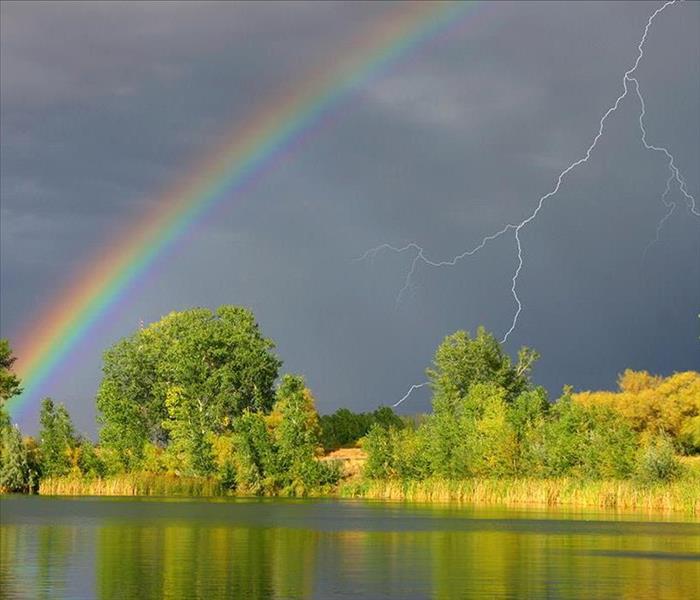 Beautiful Spring... It can also bring major storm activity and being prepared to protect yourself, your home and contents is important.
Beautiful Spring... It can also bring major storm activity and being prepared to protect yourself, your home and contents is important.
Spring-
Green grass, colorful flowers, relaxing rain showers and distant, whispering rumbles of thunder. But it isn't always this peaceful. Consider the notes below, Northeast Ohio, and take to safe steps when dangerous weather is predicted for Summit County, Portage County and/or Canton.
Tornadoes- Spring can be the peak season for tornado activity. Tornadoes occur mostly on warm spring days between 3:00 and 9:00 p.m. However, tornadoes can occur anywhere, at any time of the year, at any time of the day.
The Red Cross has safety steps people should take now to be ready if a tornado warning is issued for someone’s neighborhood:
- Download the free Red Cross tornado app for mobile devices. The tornado app puts everything you need to know to stay safe in a tornado at your fingertips. The app can be downloaded from the iTunes or Google Play stores by searching for American Red Cross.
- Know your community’s warning system.
- Pick a safe room in your home where family members can gather if a tornado is headed your way. This should be a basement, storm cellar or interior room on the lowest floor with no windows.
- Prepare for strong winds by removing diseased and damaged limbs from trees.
- Move or secure lawn furniture, trash cans, hanging plants or anything else that can be picked up by the wind and become a projectile.
- Know the tornado danger signs – dark, often greenish clouds, a wall cloud, cloud of debris, large hail, a funnel cloud or a roaring noise.
Thunderstorms- Thunderstorms are most likely to happen in the spring and summer, during the afternoon and evening. However, like tornadoes, they can happen anywhere, at any hour of the day. Every thunderstorm produces lightning, which kills more people every year that tornadoes or hurricanes.
The Red Cross has steps you can take if a thunderstorm is predicted for your area:
- If thunder roars, go indoors. If you can hear thunder, you are close enough to be in danger from lightning.
- Watch for storm signs like darkening skies, flashes of lightning or increasing winds.
Postpone any outdoor activities. Many people who are struck by lightning are not where it is raining. - Take shelter in a substantial building or a vehicle with the windows closed. Shutter windows and close outside doors securely. Stay away from windows.
- Do not take a bath, shower or use plumbing.
If you are outside or driving, there are things you should do to remain safe. Information can be found with the following link discussing what to do before, during and after a thunderstorm.
Flooding- Spring can be a time of year for flooding. Communities in the Midwest and south have already seen floodwaters inundate neighborhoods. Snow melt and heavy spring rains fill rivers and streams and flooding can occur. Flash floods occur suddenly when water rises rapidly along a stream or low-lying area. People should be prepared to evacuate at a moment’s notice and head for higher ground when a flood or flash flood warning is issued.
Other safety steps include:
- Stay away from floodwaters. If you come upon a flowing stream where water is above your ankles, stop, turn around and go another way. Six inches of swiftly moving water can sweep you off of your feet.
- If you come upon a flooded road while driving, turn around and go another way. If you are caught on a flooded road and waters are rising rapidly around you, get out of the car quickly and move to higher ground. Most cars can be swept away by less than two feet of moving water.
- Keep children out of the water. They are curious and often lack judgment about running water or contaminated water.
- Be especially cautious at night when it is harder to recognize flood danger.
Heed this advice as the Spring weather begins ! Stay safe, Northeast Ohio !
Storm Damage ? Call SERVPRO of Canton at our 24/7 Emergency Service line - 330-966-2377 or Request Help Online
FEMA Publishes Guidance for Handling Flood Losses
3/19/2018 (Permalink)
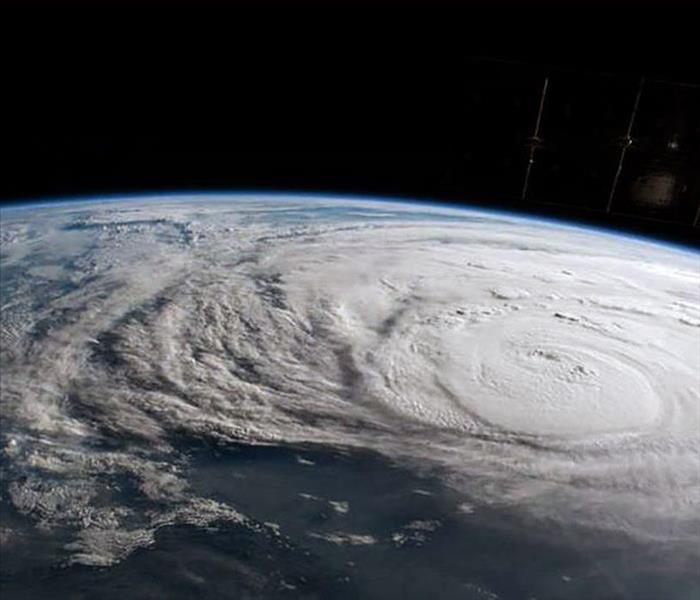 There's no easy solution.
There's no easy solution.
The 2017 Hurricane Season was a brutal one. Seventeen named storms struck the United States causing a record-setting $200 billion in damage.
Much of this damage occurred not from high winds or storm surges, but from extended heavy rains that triggered major flooding.
In an effort to facilitate prompt post-inspection advance payments to policyholders, the Federal Emergency Management Agency (FEMA) published an outline of steps, serving as guidance for handling flood losses.
- Report the loss to your insurance agent or the insurance carrier, who will in turn assign an adjusting firm who provides an adjuster to assist you with presenting the support for your loss.
- The adjuster inspects the property (scoping visit) and may ask if you wish to request an advance payment from your insurer; the adjuster will send you a detailed room-by-room unit-cost estimate of damage and a proof of loss form. If you agree, the proof of loss form should be signed to and sworn to, and upon your insurer's review and agreement, the loss is settled.
- If you do not agree, you should work with your adjuster to find a dollar amount for the covered loss that can be agreed on. Also, working with your general contractor is helpful.
- If you are unable to reach an agreement with the adjuster, you should contact your adjuster's supervisor by calling the adjusting firm.
- The supervisor should work with you to find a dollar amount for the covered loss that can be agreed on.
- If you are unable to reach an agreement with the adjuster's supervisor, you should contact your insurance carrier's claims department to discuss the amount difference or coverage issue with the claim examiner.
- If you are unable to reach an agreement with the claims examiner, you should complete a proof of loss form for the total amount you are requesting (the disputed amount plus any additional amount), and then send the signed and sworn-to proof of loss form with documentation to support the additional amount you are requesting, directly to the insurance carrier claim examiner.
- If the insurer agrees with your documentation, they will pay the amount you are requesting; or they may provide the adjusting firm with their recommendation which may lead to an additional payable amount and a new Proof of Loss. If the insurer disagrees, they will issue payment for any undisputed amount, and a written denial letter will be sent to you fully explaining the reasons for the disallowance (denial) of your claim or any portion of your claim.
- If you agree with the denial or no longer dispute the decision, the loss is settled.
- For any denial of payment, in whole or in part, which you are disputing, three options remain:
- You may send an amended Proof of Loss with supporting documentation back to the claim examiner; see STEP 8
- You may submit a formal Appeal to FEMA
- A written appeal letter must be sent to FEMA within 60 days of your insurer's denial letter, along with a copy of the denial letter and the documentation you have to support your appeal.
- You may file a lawsuit against your insurer
- A lawsuit must be filed within one year of your insurer's first written denial letter and only in U.S. District Court in the district where the property is located at the time of the loss
- However, once you file a lawsuit, you may no longer appeal your claim to FEMA or file an amended Proof of Loss with your insurer.
Storm or water damage ? Call SERVPRO of Canton's 24/7 Emergency Service line - 330-966-2377 or Request Help Online
Preparing for Spring
2/5/2018 (Permalink)
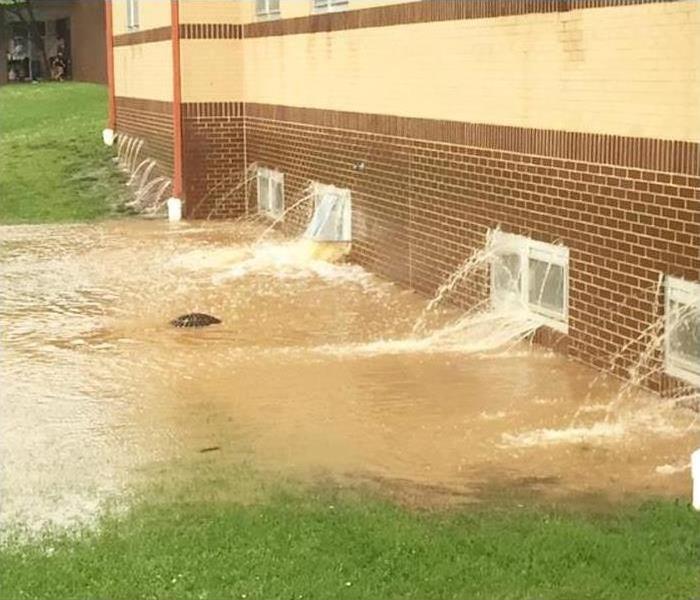 There are dangers posed by wet or flooded basements, so it's important to call a flood damage professional like SERVPRO of Canton.
There are dangers posed by wet or flooded basements, so it's important to call a flood damage professional like SERVPRO of Canton.
Well, folks, Punxsutawney Phil has seen his shadow, predicting 6 more weeks of winter. While we have trusted the Pennsylvania groundhog for countless years, additional weather-predicting rodents have called for an early Spring this year, 2018. That being said, it is never too soon to begin preparing for the back and forth weather that Spring is.
The most severe of storms Spring can bring are thunderstorms. When warm, moist air collides with cool, dry air, thunderstorms can bring lightning, tornadoes and flooding, and if not properly prepared, this can cause extensive damage to your home or business.
Below are 5 ways to prepare your home for storm damage that can cost you hundreds, even thousands, of dollars, if not kept on mind:
- Clean your gutters. Clear any debris from your gutters to make sure all the rain water can easily flow off your roof away from your home. When water can't get through your gutters, it pools on your roof and around your house. For further information on this subject, refer to our blog post, "Rain Gutters and Water Problems."
- Trim your trees. Some of the worst storm damage is caused by falling trees. A healthy, sturdy tree is unlikely to topple in high winds, but one with dead limbs, or disproportionate growth might. Spring is the perfect time to contact an arborist to evaluate your trees, and if you’ve got large trees on your property, you should have them evaluated yearly. Maintaining them will help you protect both your property and the tree itself.
- Back up your sump pump. When heavy rains come, sump pumps can get overloaded. A flooded basement can cause all sorts of damage to your contents, and when water covers wiring or electric appliances, things get dangerous. Make sure your sump pump has a battery backup just in case the electricity goes out. You might also consider installing a second, battery operated pump that will come on if the main one fails.
- Gather emergency supplies. American Red Cross recommends keeping a three-day supply of food and water for your family, and a seven-day supply of any medications. You might also add a battery operated radio, and a car adapter for your cell phone.
- Grade your yard. If water pools around your home, your foundation is in jeopardy. Ensuring that your yard slopes away from your home will keep rain water from sitting by your foundation and causing damage. Click here for a YouTube tutorial, provided by "This Old House," on how to grade your home. Most lawn companies, however, offer this service.
As we get closer to the rainy season, consider these five steps to keep your home and family safe.
Do you have water problems ? Call SERVPRO of Canton for help- 330-966-2377
Mobile Homes- Are They Covered?
10/5/2017 (Permalink)
 Wind-damaged mobile homes in Oklahoma.
Wind-damaged mobile homes in Oklahoma.
We might be in Ohio, away from all the severe hurricane damage to trailer parks in Florida, Georgia and Texas, but this does not change how the events have changed our perspective on these homes' insurance coverage.
That perspective being: this is important!
Enlightened by Property Casualty 360's article, Mobile homes — A unique insurance exposure, a mobile home serves as both a home and a vehicle. When on the road, authorities treat it as a vehicle, and once settled down in a trailer park, it becomes a home.
Because of the portable and lightweight nature of mobile homes, wind is a significant hazard! Hurricanes and tornadoes, especially, can cause significant damage to mobile homes with the high winds easily flipping, uplifting and damaging the home.
Strap-downs and straps are required to offer stability from these cases, and some newer models use frame anchors tied to the chassis. Some carriers may require a particular type of tie-down for a specific part of the country. Wind zone ratings will indicate how much wind a mobile home can withstand.
With all this in consideration, is the part-vehicle part-home eligible for homeowner's insurance? Coverage is offered for when the mobile home is on the move, covering collision, collision defined as it is in the auto policy.
"As long as the collision happens while the vehicle is being transported there is coverage," Property Casualty 360's article reads. "Not covered is a loss caused by the home making contact with the transportation vehicle that results in damage to the home unless the transport vehicle was in an accident. The coverage applies for 30 days from the effective date on the endorsement. Coverage also includes upset of the home while it is in transit or stranding or sinking if the home is on a licensed ferry line."
Mobile homes require their own coverage needs, meaning its policy will be different from a homeowner's policy. There are carriers that specialize in mobile homes and the coverages they need:
HomeInsuranceWeb.com
Do you have storm damage? Call SERVPRO of Canton at 330-966-2377
Water Damage After A Major Storm
9/6/2017 (Permalink)
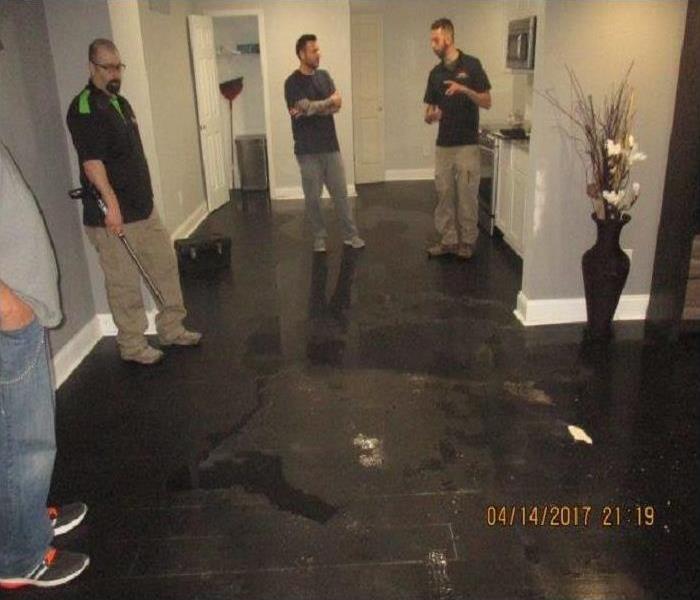 SERVPRO Canton arrives quickly & starts the water extraction process almost immediately, minimizing the damage and the cleaning and restoration costs.
SERVPRO Canton arrives quickly & starts the water extraction process almost immediately, minimizing the damage and the cleaning and restoration costs.
When a major storm passes close to the house, the home may suffer water damage that is difficult to repair.
There are many things a family can do to begin repairing any destruction, but a certified professional will likely be needed to get rid of any serious health or structural threats. Contaminated storm surges or floods can carry pathogens and become a breeding ground for mold. If allowed to fester, these mold spores can spread throughout the building and become even more difficult to remove. In many cases, governmental agencies could condemn the structure if the microbial threat is too great.
The main reason a home is sensitive to water damage is because moisture is difficult to detect once the floods recede. Standing liquids can encourage microbial growth within 24 hours and can saturate all kinds of textiles and seep through drywall. Moisture may collect behind the walls, where mold and bacteria may multiply out of sight.
Professional restoration services can quickly identify what items in the home are compromised by water damage. Normally, anything that is porous may need to be discarded if it has come in contact with contaminated fluids. These items, like mattresses, box springs, pillows and particle board, trap more moisture than other materials and foster the growth of microbes.
A family can prepare for professional cleaning by getting rid of these items before the technicians arrive, but be sure to properly record and itemize the items for insurance purposes prior to disposing. Once professionals arrive at the building, they will be able to track down any pockets of excess moisture and remove them.
It’s important for a family to hire professionals that are certified through a reputable organization. Technicians trained in this area know how to find compromised areas and do what it takes to restore them.
Flood damage in your home or business? Call SERVPRO of Canton today at our 24/7 Emergency Service Line - (330) 966-2377 or at our Online Help Line.
Storm Damage: Validating Claims Through Weather Data
9/5/2017 (Permalink)
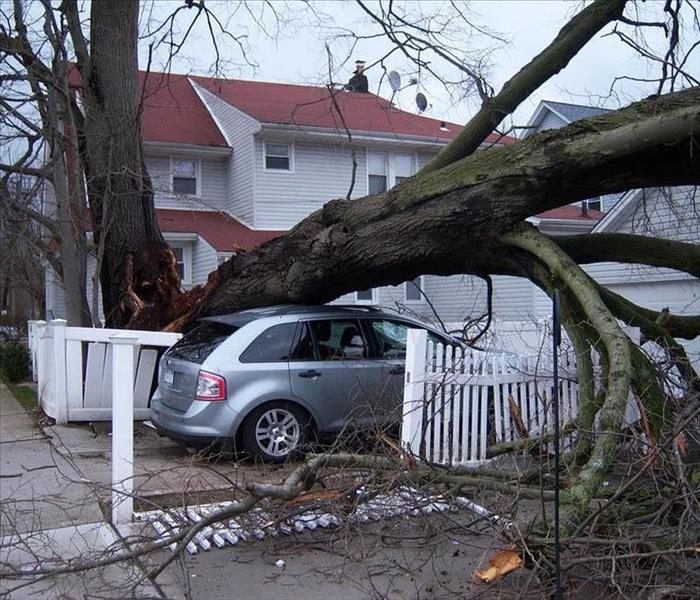 In the past year, the U.S. was hit with 8 major storm and climate-related events that each caused more than a billion dollars in property damage.
In the past year, the U.S. was hit with 8 major storm and climate-related events that each caused more than a billion dollars in property damage.
Data and analytics can go a long way in improving inefficiencies and processes, weather data, to be specific, holding a significant value.
Extreme weather events will always occur and certain areas of the country are more susceptible than others. For the insurance claims industry, this data is especially critical to verify claims following an extreme weather event.
According to Aite Group, "79% of insurers believe that data and analytics will have a significant impact on meeting the needs of [property and casualty] (P&C) customers."
Insurers have several options in capturing data to enhance insurance claims. Drone assessment is among the list for property damage assessments. Pairing weather data with drone services and their accurate imagery of a site could add validity to a claims decision.
Lightning and hail data and additional advanced weather data technologies are imperative for insurance companies in improving internal efficiencies as well as customer operations.
Do you have storm damage? Call us at our 24/7 Emergency Service number, 330-966-2377.
HVAC Compressor Damage: Lightning or Wear & Tear?
8/15/2017 (Permalink)
In the summer months, when severe weather is most prevalent, property carriers see an increase in claims for lightning damage to HVAC equipment, and most often to the compressor.
HVAC compressor damage due to lightning is commonly misdiagnosed. More often than not, an HVAC claim that is originally reported as damaged by lightning is ultimately found to have suffered damage due to some other cause of loss.
No matter the time of year, one of the most common culprits of compressor failure is mechanical damage due to age-related wear and tear. Nearly 43% of all compressors (regardless of how the damage is initially reported) fail due to this cause of loss.
Considered the “heart” of the HVAC system, the compressor is not only critical to proper system function, but can often be impossible to repair and expensive to replace. Moreover, without understanding the root cause of compressor failure, the simple act of replacing this component may not ultimately resolve the overarching issue. When handling HVAC claims, it is critical to understand what caused the compressor to fail before agreeing on a scope of repair for settlement.
For additional information on mechanical damages versus electrical damages, click here to the source of this information.
Vehicles After Flooding: Filing a Claim
8/14/2017 (Permalink)
 No region is safe from flooding. All 50 states are subject to flash floods.
No region is safe from flooding. All 50 states are subject to flash floods.
In the aftermath of a natural disaster, it is important for consumers to be aware of the warning signs of a flood damaged vehicle. If you are in the market to buy a used vehicle, be sure to inspect it carefully.
The following tips on filing a claim will help those with flooded vehicles after a storm:
- Contact your insurance agent as soon as possible. Have your policy readily available and find out whether the damage is covered under the terms of your policy and how long you have to file a claim.
- Your automobile insurance policies cover flooding if you have purchased comprehensive coverage. If you only have liability coverage, your vehicle is not covered for flooding.
- Minimize your losses and document the damage. Take photos of any damage and then make whatever reasonable temporary repairs that are needed.
- Remember that flooding is generally not covered under standard homeowners and renters insurance policies. Flood insurance is a separate policy through FEMA’s National Flood Insurance Program and some private insurers.
- Ask for identification from any agents, adjusters or contractors. Do not sign any contracts for repairs until you have been instructed to do so by your adjuster and you have called the Better Business Bureau in your area.
- Don’t be afraid to file a claim. Storms are considered “Acts of Nature” and an insurance company cannot cancel, refuse to renew or increase the amount of a premium on a homeowners policy based solely on this type of incident.
Do you have storm damage? Contact our SERVPRO franchise at (330) 966-2377 or request help online.
Windstorm Damage: Whose Insurance Covers the Loss?
7/28/2017 (Permalink)
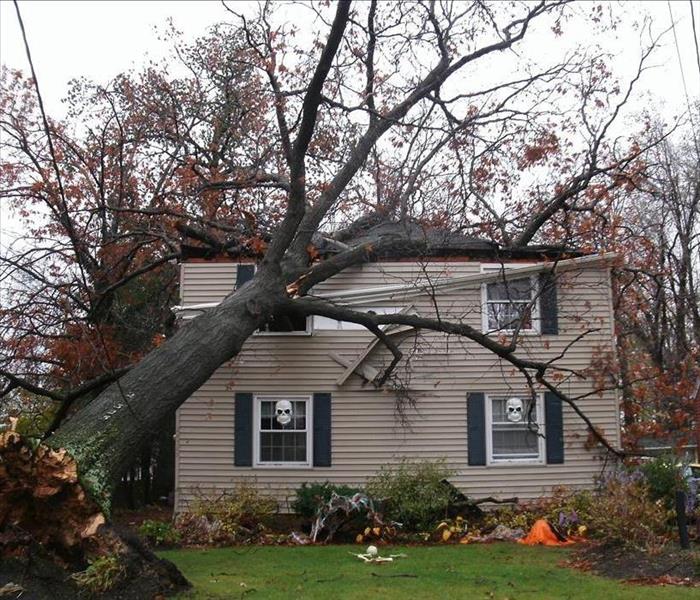 Straight-line winds are common with the gust front of a thunderstorm or originate with a down-burst from a thunderstorm.
Straight-line winds are common with the gust front of a thunderstorm or originate with a down-burst from a thunderstorm.
Yes, windstorm damage is covered on a standard homeowner's insurance policy. But whose homeowner's insurance policy covers the loss?
First, it is important to understand what windstorm insurance policies cover. Windstorm insurance is a special type of property and casualty insurance designed to cover damages caused by high winds. Windstorm insurance may cover damages from hurricane-force winds, tornadoes, hail and other weather events that are accompanied by wind gusts that exceed 35 miles per hour.
A hypothetical tree falls on your house.
- Scenario 1: your tree falls on your house. Your homeowner's policy will provide coverage up to your policy limits, after you pay the deductible. The coverage extends to cover damage to your main home, garage, shed or other additional buildings and structures such as a fence. If there is damage to the structure of the house, debris removal is also covered, up to policy limits.
- Scenario 2: your tree falls on your neighbor's house. The basic rule is that the insurance policy of the property that was damaged pays for the loss.
- Scenario 3: your neighbor's tree fell on your house. Your homeowner's insurance policy should pay for any damage per the property claim.
Please note that homeowners insurance usually won't cover a loss caused by negligence or a maintenance-related issue. So if the tree was rotting and ready to fall down before the storm, homeowners insurance likely would not cover the damage the tree caused to your home.
Flood Safety Awareness Week is March 13-19
3/17/2016 (Permalink)
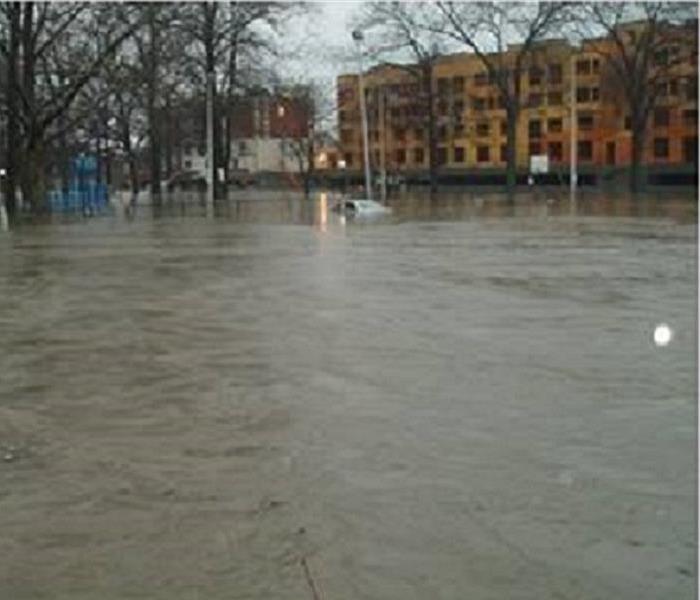 Floods can be unpredictable and cause a lot of damage. Stay informed and prepared as flood season approaches!
Floods can be unpredictable and cause a lot of damage. Stay informed and prepared as flood season approaches!
March 13-19 is Flood Safety Awareness Week. According to the National Weather Service, "Each year, more deaths occur due to flooding than from any other severe weather related hazard. The main reason is people underestimate the force and power of water. More than half of all flood related deaths result from vehicles being swept downstream. Of these, many are preventable." As flood season approaches, now is a great time to review such topics as the dangers of flooding, driving through water, and flood insurance. Additional resources are available at http://www.weather.gov/okx/FloodAwarenessWeek2016.






 24/7 Emergency Service
24/7 Emergency Service


